Text
A Time for Godzilla Aficionados to Rejoice!
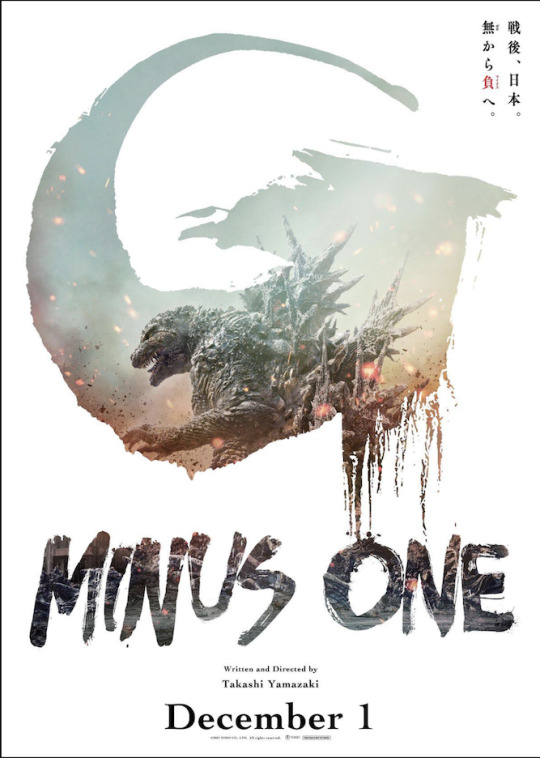
GOJIRA was premiered on November 3 in 1954, and that film’s release created one of the longest franchises in film history, which is now thriving vigorously. Directly inspired by Ray Harryhausen’s THE BEAST FROM 20,000 FATHOMS (1953) and perhaps even the Fleischer Superman cartoon THE ARCTIC GIANT from 1942 (which also seems a bit of a plot source for the Harryhausen film), there have been periods wherein Toho Studios have gone on hiatus, and many years would pass before new Godzilla content would arise. Now a feast of daikaiju goodness makes it a particularly fine time for we Goji fans. The American LEGENDARY company has a successful MonsterVerse (including films, live action and animated series) with a sequel to their energetic GODZILLA v. KONG film due out in March of 2024, and a live action series about to be released on Apple’s streaming platform featuring the mysterious MONARCH agency—said to be enhanced for their upcoming augmented reality headsets. Toho last released a live action Godzilla film in 2016, SHIN GOJIRA, which artfully reimagined their great god-beast and lampooned Japan’s frustrating bureaucracy. Since then, two Toho animated series have been released which also reboot and rethink Godzilla: GODZILLA: PLANET OF THE MONSTERS and GODZILLA SINGULAR POINT. And Netflix has two seasons of PACIFIC RIM: THE BLACK as well as GAMERA: REBIRTH, coming in September—a glut of giant monsters is upon us!
At last, Toho has begun serious publicity for their new live action film GODZILLA: MINUS ONE, set to be released in Japan on November 3rd, and then, in US theaters on December 1st—a first time in the history of this franchise that a US release has so quickly followed the Japanese premiere. They dropped a poster and a teaser trailer less than a week ago, and over this past weekend an exhibition of materials concerning this film’s director, Takashi Yamazaki, opened. He writes, directs, and oversees and designs the special effects. It included a statue of his new Godzilla as well as a very sketchy storyboard amongst other bits of memorabilia from his other films.
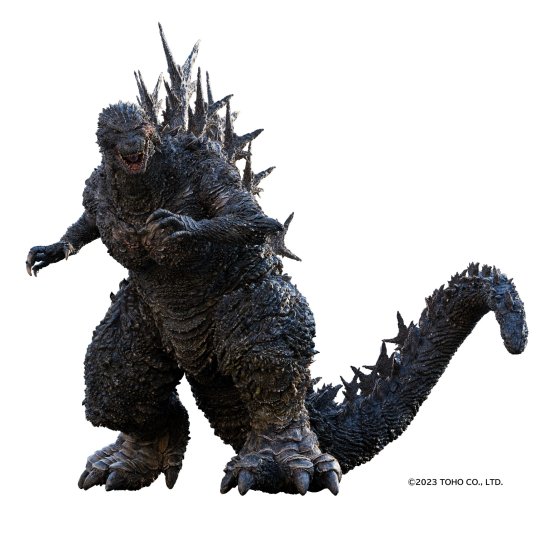
Yamazaki has depicted Godzilla twice before in what amount to cameos. In his Always: Sunset on Third Street 2, Godzilla appears in a fantasy sequence, while in 2021 he directed Godzilla the Ride: Giant Monsters Ultimate Battle which features Godzilla, King Ghidorah, and Rodan. He has continuously evolved his depiction of Godzilla as a CGI creation, and the version in the about to be released film is quite closely based on his previous version—though with enlarged dorsal plates and added details. Yamazaki blends aspects of other Godzilla designs into his own, particularly from the Toho Heisei series, but also there are some aspects of Legendary’s version as well.
Yamazaki had been rumored to be working on a Godzilla film, and Toho confirmed in late 2022 that it was happening, with a mysterious logo shaped like a G—that looked like it contained the shape of a new Godzilla—as well as the opening date, but they did not offer a title, poster, and teaser until about 5 days ago. Not long after the original confirmation and mysterious logo, a plot rumor emerged that suggested the film was set in the 1940s, after Japan had been nuked by the USA. Casting calls that astute fans discovered before this announcement confirmed that they were looking for actors who could be period correct. The rumor went on to suggest that the basic premise was that two Godzillas were to be used, one who was horribly burned by the nuclear strikes, and vengeful towards humans, while the other was unburned and thus more peaceful. The angry Godzilla was said to look much like the design from The Ride, while the other would have smoother skin, smaller dorsals and was described as somewhat “whale-like.” Also mentioned was that there would be a re-imagined version of Dr. Serizawa and his Oxygen Destroyer, both playing a major role in what was clearly emerging as a reboot entry into the series.
Back to the storyboard—Yamazaki must have selected it for inclusion in this public exhibition, and, if one enlarges it, one can see what looks like a sequence depicting both the angry Godzilla (Toho now calls him NegaGoji) as well as the peaceful one (I call it KujiraGoji) and the scene displays an ocean encounter with these two daikaiju as well as a small boat with three people (one wearing glasses). The plot rumor had mentioned a climactic scene wherein Dr. Serizawa, his sister, and a friend, use a small boat to take his Oxygen Destroyer to use on these two creatures who had been spotted together. So, the storyboard seems to be solid evidence confirming that detail of the plot rumor. Now, the rumor was early on and could have been derived from an early treatment or rough script produced by Yamazaki, so the actual film may have changed significantly since the rumor and the drawing of the storyboard. Yamazaki’s selecting this for exhibition seems like he might be having fun, hiding some significant aspect of the film in plain sight. His drawing is very loose and layered.
Below you can see the enlarged story board image—which is frankly almost Rorschach-esque. In my image I have outlined in magenta how Yamazaki has depicted NegaGoji (his exaggerated dorsal plates are clear), and I've outline in green KujiraGoji. It looks to me that Yamazaki has drawn an image wherein N-Goji might be following K-Goji underwater. He's overlayed this with eyes, which I suspect are notes to himself as to what eye expressions he's considering for the Gojis. I've outlined in orange the shot of the small boat by what I think is the submerged K-Goji, who one can see is drawn very differently from N-Goji, particularly with the lesser dorsals and the rather short arms and legs. The Goji by the boat is like the one above outlined in green. Of course you can easily see the images toward the bottom left that show three people in the boat, which is how the plot leak described the scene.
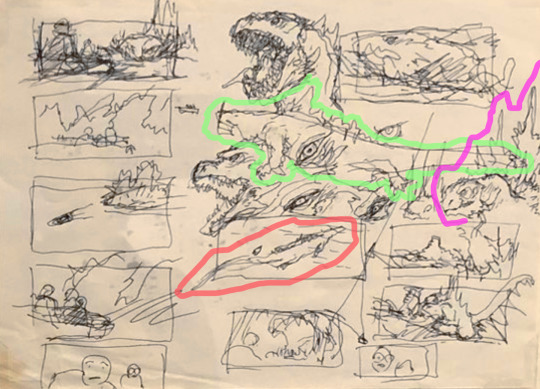
Whether or not the rumors, or what appears to be a pertinent story board, are actually indicators of the film to come, I’m certainly looking forward to Toho’s latest attempt to interpret Godzilla. Yamazaki has stated “In order to depict this, the staff and I have worked together to create a setting where Godzilla looks as if ‘fear’ itself is walking toward us, and despair is piled on top of despair.” That piques my interest! I quite enjoy the design and look forward to adding some new idols to my collection once the figures are released—and a number of them have been announced along with release dates. There is also supposedly an online Godzilla store in the works, to make it easier to sell Japanese merchandise to fans in the US. And plans are afoot for several viewings of the film in my local cinema accompanied by my fellow Gojira devotees.
There have been some test-screening revelations about GODZILLA X KONG: THE NEW EMPIRE, and I’ll be back to discuss those in another blog entry.
It is indeed a good day to Hail Godzilla!
—Peter H. Gilmore
#Godzilla#Godzilla Minus One#Takashi Yamazaki#toho studios#legendary monsterverse#shin gojira#daikaiju
25 notes
·
View notes
Text
Danny Elfman: Concert Music

I first became aware of Danny Elfman in 1985 when I went to see PEE-WEE’S BIG ADVENTURE. While I had seen Pee-wee Herman perform his delightfully odd standup on TV, I was excited to see what he’d do with a full-length feature, and I was not disappointed. The tale of a boy and his bike was supported by music that amazed me. Scoring comedy is very difficult, and here was a composer, with clear roots in Bernard Herrmann, knocking it out of the ballpark with the perfect quirky musical accompaniment for Pee-wee’s epic cross-country quest. I next noted Elfman’s work in 1989, deftly underpinning Tim Burton’s sweeping BATMAN, wherein a driving, leitmotiv-driven score perfectly captured The Dark Knight, his nemesis, The Joker, and the milieu of Gotham itself. And thus began my love of this very skilled and prolific composer’s works. I began looking for his name as composer when movies were released, for I knew there’d at least be a fine score, even if the film wasn’t otherwise fully up to snuff, likely with a soundtrack album to enjoy by itself. The many soundtrack CDs in my library composed by Elfman are often in rotation. They have provided me with hours of fulfilling listening.
To my surprised delight, in 2006 I discovered Serenada Schizophrana, commissioned by the American Composer’s Orchestra and written in 2004—Elfman’s first exploration of writing a concert piece for orchestra. It is a quirky suite of six movements and lasts about 42 minutes. In the program notes he presents quite clearly that his influences include Bernard Herrmann, Nino Rota, Dimitri Tiomkin, Max Steiner, Erich Korngold, Sergei Prokofiev, Igor Stravinsky, Béla Bartók, Dmitri Shostakovich, Carl Orff, Kurt Weill, Duke Ellington, Harry Partch and Philip Glass. Much like Herrmann often did, the large orchestra (including voices) is used both selectively and deftly amongst the movements for coloristic purposes. The entire ensemble does not continually play, but various instruments are called-out to match the mood for each separate movement. There’s an almost Lewis Carroll sensibility in the progression of ideas—whimsical, perky, but at times ominous and even threatening. A unique beginning!
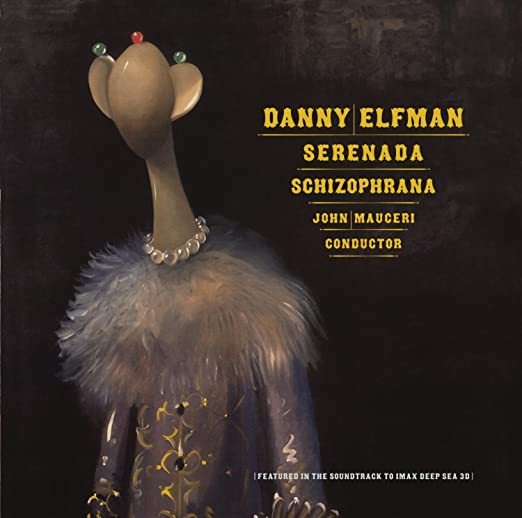
In 2008, Elfman was commissioned to write a ballet score for Twyla Tharp: “Rabbit and Rogue.” Once again, in six movements there’s a wide range of styles and colors to be found, of particular interest is the Gamelan sensibility which evokes the earlier works of Colin McPhee, and there are even ragtime piano passages! This piece is about 46 minutes in length and certainly the aficionados of his film scores will find familiar riffs and textures, but these flow in an ongoing stream of propulsive ideas that clearly could provide the impetus for dancing.
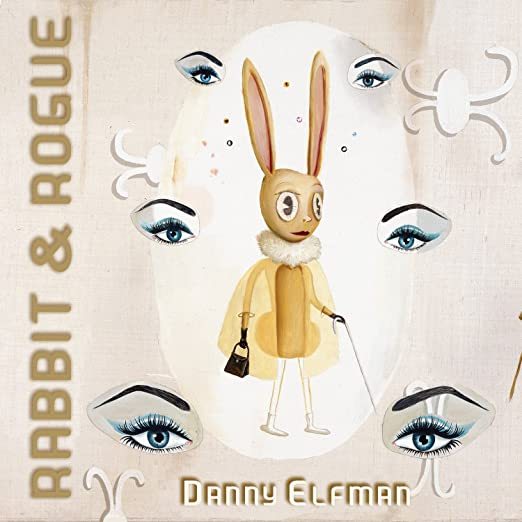
2017 was the year in which Elfman’s Violin Concerto “Eleven Eleven” was composed and premiered. Violinist Sandy Cameron brought her technical expertise to the composer so he could craft a piece that was both playable and challenging for the soloist—as is expected of a fine concerto. The title is derived from the fact that the piece is 1,111 measures long, and that corresponds to the fact that the composer’s surname means the “11th man” in German. It is a hefty work of four movements that lasts over 50 minutes, and, that Elfman listened to many violin concerti but was primarily drawn to those by Prokofiev and Shostakovich, is heard quite clearly by a knowledgable listener. The orchestra is huge and there’s even a cadenza in the second movement for violin and percussion. It does not end with an upbeat finale, as is often the case with traditional concerti, but comes to a massive climax and then retreats to the dark, pensive mood of the opening.
In his liner notes to the recording of this concerto, Elfman explains that his compositional goal is to create a fusion between 20th-century “post-Romanticism” with the rhythms and harmonies of late 20th-century classical works. He has stated that he loves a challenge and feels that writing concert music that follows his continually evolving and gear-shifting musical “stream of consciousness” is liberating, and a way to bring the worlds of listeners to concert and film music together. His concert scores clearly bear his film scores’ musical characteristics, but he works to bring a complexity and structure to these efforts that can satisfy those who enjoy the great masters of classical music. That’s a hell of a challenge, but Elfman is evolving quite well to meet this concept and crafting some potent tonal music that goes from the intimate to the opulent.

I also note some Mahlerian influences, but that could have come in via both Shostakovich and Korngold, who were both deeply studied in Mahler’s works. There are even some aspects of Leonard Bernstein, in the jazzy flavor and rapidly shifting meters and uneven beats in measures, as well as some characteristics of the richly scored works of Respighi, particularly his manic “Feste Romane.” Ultimately, Elfman has distilled these many influences into a style that, in its almost schizophrenic progression, immediately is recognizable as his own, and that is a hallmark of a great composer.
The Piano Quintet, premiered in 2018, is a more intensely intimate work in which once again the shade of Herrmann hovers over the typical blend of Elfman’s circus of rapidly shifting ideas. There was also a Percussion Quartet premiered in 2019, which I’ve not yet heard. Via BMI in March of 2019, Elfman announced his upcoming roster of concert works:
“I have accepted a symphonic commission for the National Youth Orchestra of Great Britain for next summer’s Proms festival in London 2020. Should be wild! One hundred and sixty-five extremely talented young musicians, all on stage together. I’ve also accepted a concerto for percussion and orchestra written for Colin Currie who’s an amazing British percussionist, to be played with the London Philharmonic Orchestra in London, spring of 2021. I’m also hoping to finalize plans for a cello concerto that I’m super excited about, but it’s not finalized yet. I’m also working on a “semi-secret” personal project that involves a chamber orchestra and my own voice.”
So, there is much to look forward to for the concert hall from this remarkable composer, who’s progress reversed the course of one of his influencers—Erich Korngold (1897-1957). Korngold began as a child prodigy, writing concert music and operas and eventually, after escaping the Nazis and settling in Hollywood, he became one of the most influential masters of film scoring. His concertos for violin and cello as well as his powerful Symphony have been both recorded and played in concert halls with increasing frequency as time passes.
I have hopes that Elfman might try his hand at a symphony at some point, though a concerto for orchestra might more likely suite his temperament—rather like Bartók’s masterful effort from 1943 which in five movements has a similar gamut of moods and colors as one now finds in Elfman’s efforts. Its timing of close to 40 minutes is also in the realm of Elfman’s current compositions. But, I could also see him writing something along the lines of Mahler’s Symphony No. 3. That six movement symphony is a vast canvas using a huge orchestra and vocal soloists to depict an evolutionary progression from insensate Nature through the evolution of plants and animals to the arrival of human consciousness and both the sorrows and ecstasies inherent in our species. The movements vary wildly in mood and in orchestration, and the work lasts roughly 105 minutes, being one of the longest symphonies in the standard repertoire. I suspect, if Elfman could find the right subject matter to inspire his thinking, that he too might create something along those lines in scope and scale. Whatever he is moved to create, I’ll be eager to hear all that he produces, for he is certainly a master musician who works very hard to compose pieces that will challenge, thrill, and, in so many ways, deeply move his listeners. I’m certain his film and concert scores will be cherished for many years to come.
—Peter H. Gilmore
#Danny Elfman#eleven eleven#violin concerto#serenada schizophrana#rabbit & rogue#film scores#piano quintet#Bernard Herrmann#bela bartok#Shostakovich#Prokofiev#erich wolfgang von korngold#Sandy Cameron#pee-wee's big adventure#batman#mahler#leonard bernstein
21 notes
·
View notes
Text
Hurwitz on Classical Music
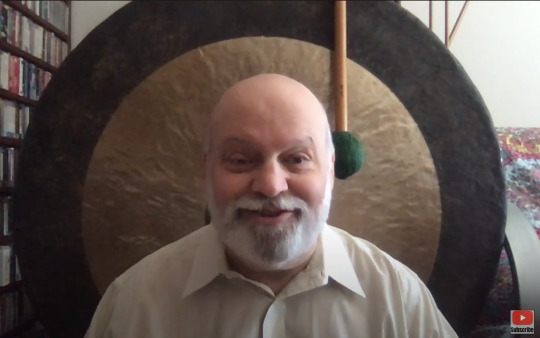
David Hurwitz is a music critic who currently has a YouTube channel upon which he presents his ever-growing body of reviews of recordings of classical music. I very recently discovered this wonderful resource, but I had known him over the years for his written reviews for High Fidelity, Fanfare, Amazon.com, and Classics Today (he’s a founder and executive editor). An ebullient curmudgeon with a rich vocabulary, Hurwitz presents his thoughts and feelings in an earthy, energetic manner. Clearly, he’s quite “well-listened”—and I’m curious as to how he currently evaluates recordings, whether he uses headphones or speakers and what sort of sound-reproducing facilities might be his “rig.” There are quite a few videos, with sometimes several added in a day, so I’ve yet to find whether he’s mentioned that somewhere amongst them.
Unsurprisingly, since Hurwitz resides in Brooklyn, over the decades we’ve both attended many of the same concerts. I lived in Manhattan for 35 years, near Carnegie Hall and Lincoln Center, and was at many performances in those venues as was he. We’ve likely passed close to one another a number of times without meeting, a pity, since I suspect we’d enjoy hours of conversation about the music for which we both have such passion. I value that Hurwitz is a fellow musician (a percussionist—as was I in my early years of college) and he’s also a fellow tam tam aficionado—he mentions he has a collection of them amongst his personal array or percussion instruments (I’d love to spend some time with those!). He is deeply conversant with the scores for the works he’s discussing, and may even have played in performances of such pieces over his career. He also values many of the same mainstream composers I favor (including Mahler, Shostakovich, Dvořák, Haydn, Strauss, Sibelius, Brahms and Bernstein) and he has written “Owner’s Manuals” regarding their works. I’m now tempted to read those. He’s even done scholarly rebuttals to the folks who promote early performance practices regarding use of vibrato. Hurwitz, contrarily to most, contends it was commonly in use. He also shares my love for some lesser-known composers such as Nielsen, Leifs, Gillis, Lloyd, Englund, Koechlin, Pettersson, Raff, Shapero, Kalliwoda, and Magnard.
From the episodes I’ve currently enjoyed, Hurwitz typically does not play examples of the recordings that he is discussing, and, to be fair, that would add a great deal of time to the video blog, so that’s not a problem. He may at times be speaking to the part of his audience who are also similarly well-listened, dismissing some performers who are generally considered to be weak in certain repertoire without necessarily making it abundantly clear why that would be the case. Those coming to this channel who are new to classical music might not at first grasp why he either raves for some or condemns others to the “schwach” bin. However, I’m discovering that his tastes frequently coincide with mine, as he has similar aesthetics about what qualities make for both exemplary music and performances of it. And, he’s made clear, both in the episodes and in the spirited comment stream for them, his perspective. These quotes from him in response to comments on his review of versions of Beethoven’s 9th Symphony (he wears a tie when discussing this work) make things abundantly clear:
“It's not wisdom, just experience, and there are many commentators who, I'm sure you will discover, also bring a useful fund of experience to bear on their judgments. There are also a lot of fakes and phonies, unfortunately, but that comes with the territory. If I may make one suggestion? Take your time, live with the music and your favorite versions, then perhaps sample another and see how it strikes you. There's no hurry—the point is that the experience should be as enjoyable as possible. I meant what I said originally—there is no performance out there that someone doesn't love, but if you want to try to get the "best" versions, more important than seeking out the advice of others is to know your own preferences, so you have a basis to judge what they say. Be selfish. It's your money and your time!
“Of course no hard feelings. You are more than free to disagree with me, and I respect that. Of course Karajan sounds different from Szell, and I greatly prefer Szell, but I chose Karajan not because I like him, but because he had a distinct point of view that he realized superbly in that recording, and I felt obliged to give credit where credit was due. That is the difference, sometimes, between criticism and mere fandom. I do feel an obligation to acknowledge different interpretations, take into account the general consensus, and consider other factors beyond my own personal preference. It may not exactly be "objective," but it isn't totally "subjective" either. I see it more as an aspect of professionalism as a critic. I take great pride in recognizing excellent work, whether I happen to like it or not, and telling listeners about it so that they can come to their own conclusions.”
I’ve been pleased to discover that Hurwitz shares my thinking about the quality of Rachmaninov’s Symphony No. 1 (his best—and we share admiration for Ashkenazy’s recording), but, in contrast, I do like the actual bell sounds in the first movement, which for me directly evoke Rimsky-Korsakov’s orchestration of the Boris Godunov coronation scene while Hurwitz prefers that passage to be less literal. My readers might know of my Mahler connection (including my years with the Gustav Mahler Society of New York which began in 1976) and I frequently find that Hurwitz knows and appreciates some of the more obscure Mahler recordings…Muti’s 1st, Slatkin’s 2nd, Barshai’s 5th. Our listenings and evaluations often coincide, but we don’t always agree. While he prefers the wind band arrangement, I love hearing the full orchestral version with choral parts for the Berlioz “Funeral and Triumphal Symphony.” Singing “Gloire et Triomphe” while conducting “air baton” always adds to my enjoyment of that splendid work.
Hurwitz’s video blog reviews are definitely worth your while, whether you are beginning to explore classical music or are a seasoned aficionado. So far, he’s clued me in to some treasures that I’d not yet enjoyed, including Finn Mortensen’s splendid symphony and Fricsay’s superb reading of Dvorak’s 9th. Many of the recordings he mentions are currently posted on YouTube. While he doesn’t provide links, but you can easily find them, so you need not deplete your funds ordering hundreds of CDs. Do your listening and then you can purchase those CDs that intrigue you most. You’ll quickly get used to his raspy voice and cheerful monologue. The sight of his smiling face framed by the pagan halo of one of his substantial tam tams will be a welcome sight.
For many, getting acquainted with classical music is a rather Hellish experience. I know, for I’ve spent decades assisting people to discover the glories achieved in that art form. There are centuries worth of material and thousands of performances of wildly varying quality, and that can be a formidable barrier. Would-be initiates to this vast repertoire often need a knowledgable guide. So, I suggest you let Mr. Hurwitz be Virgil to your Dante as you descend what might seem at first to be the nine circles of the abyss, but which will instead ultimately prove to be an opening of your ears to transcendent beauty. Queue Liszt’s “Dante Symphony”—with the optional fortissimo conclusion to the choral Magnificat—volume turned up!
—Peter H. Gilmore
#David Hurwitz#classical music#classical music reviews#symphonic music#chamber music#choral music#Beethoven#Mahler#Shostakovich#Nielsen#franz liszt#antonin dvorak#leonard bernstein#charles mackerras
3 notes
·
View notes
Text
In Memoriam Krzysztof Penderecki (1933-2020)
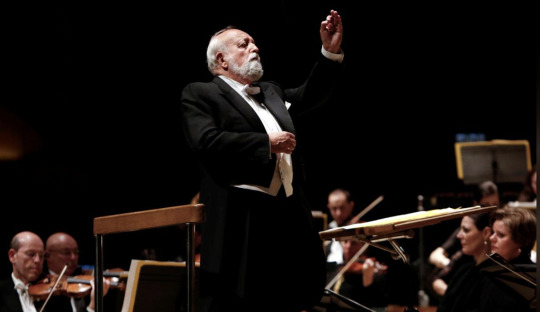
One of the great 20th Century composers, and also a fine conductor, Penderecki was a defining force in the realm of music during my life. He first crafted revolutionary, expressionistic music that offered new ways for traditional orchestral instruments to be played. After much success in this style, he returned to a personal exploration of past European classical traditions, inspired by Bruckner, Mahler and Shostakovich to write large scale tonal symphonies which are splendid achievements in that form of expression.
His large body of work includes eight completed symphonies, four operas—one based on Huxley’s The Devils of Loudon and another on Milton’s Paradise Lost, many choral and vocal works, concerti, and chamber music. I first heard of him via his “Threnody to the Victims of Hiroshima”—written in 1960 for 52 stringed instruments. It is a “must listen” piece for anyone who is interested in music. This video link includes the score so you can follow the unusual notations which the players were challenged to realize. It is a harrowing listen and indeed it created a style since employed by film composers who want to accompany scenes with music of extreme anguish. Many of his works are reactions and memorials to tragic world events. Directors have used pre-existing compositions by Penderecki in their films including Friedkin (THE EXORCIST), Kubrick (THE SHINING), Scorsese (SHUTTER ISLAND), and Lynch (INLAND EMPIRE), thus many film aficionados have come to hear his music. He was well recognized and won numerous awards, and was also known as an educator for promising young musicians. One of his other projects was a nearly 75 acre arboretum in which he had 1,700 species of trees planted over the course of about five decades. He saw this as a sort of ongoing “unfinished symphony.”
Penderecki had made an immense mark with his cutting-edge works, but he began to move away from this earlier atonal style and cemented that with the composition of his Symphony No. 2, sometimes called his “Christmas Symphony,” since a fragment of the carol “Silent Night” is used in the work. I was fortunate enough to attend the rehearsals as well as the premiere performance with Zubin Mehta conducting the New York Philharmonic on May 1, 1980. During the rehearsals, which included a full run through, I sat near some members of the press and overheard their negative reactions to this piece. They seemed to feel it was a betrayal of Penderecki’s avant garde preeminence. I quite loved it—still do, and was subsequently fortunate enough to attend performances in Carnegie Hall and then-named Avery Fisher Hall of his symphonies No. 3 (1988-95, which cleverly employs rototoms), No. 4 “Adagio” (1989), and No. 5 “Korean” (1991-92, which includes bell gongs and has a quirky lengthy fugue theme). Penderecki conceived of his Symphony No. 6 as a sort of “song symphony” much as Mahler had done with his Das Lied von der Erde—even to using the same source of Bethge’s German translations of Chinese poetry as texts, but he put it aside to do his massive choral Symphony No. 7 “The Seven Gates of Jerusalem” (1996) and then his Symphony No. 8, “Songs of Transience” (2005), which featured choir, vocal soloists and even calls for 50 ocarinas to be played by the chorus members. The Symphony No. 6 was finally completed and debuted in 2017.
When asked about his projected Symphony No. 9 back in 2018, the composer mused:
“Good question. Of course, I am going to write it. I have sketches. But I am not in a hurry. I want this piece to be an important piece. The Ninth Symphony is supposed to be something special. Forty minutes (in duration), something like that. I’m writing one big movement. I’m not sure if it will be with choir or not. I have sketches. I cannot say anything more. Absolutely different sketches, which I can put together, or maybe start from the beginning.”
I hope that whatever sketches he might have produced will be saved and eventually released for study, and possible performance—if they reached that level of completion.
Back in 1984 I attended a series of concerts under the auspices of the New York Philharmonic titled “Horizons ’84.” During the evening concert on June 1, amongst the performers was Diamanda Galás, doing a multi-movement solo piece of her own. She strode onto the stage, wearing an impressive dark gown, and had three microphones on stands before her into which she projected her wide-ranged ululations. These were subjected to reverb and repetition, weaving a bizarre and elaborate sonic tapestry. For me, I felt it had become quite repetitive and my interest evaporated fairly swiftly, and I noted in the program that there were several lengthy movements to come. During her pause between movements, I arose and moved from my seat rightwards toward the aisle to make my exit. When I got to the aisle, to my surprise, I was face to face with Penderecki. He was accompanied by a striking blonde woman, both of them coming from the same row, but the opposite side of the aisle. They clearly had similarly run out of patience with Ms. Galás’ warblings. We looked each other in the eye, smiled, shrugged and shook our heads. I gestured with my arm that he and his companion should precede me up the aisle to exit at the rear of the hall. And so we did.
My admiration goes to this splendid composer who has gifted us with hours of fascinating and moving music. I’m sure he has touched many who enjoy the genres he assayed, and that he’ll long be remembered for his entire range of expressive works, from his youthful radicalism to his mature reflective explorations of the past. Bravo, Maestro Penderecki, for your uncompromising pursuit of your aesthetics and a life very well lived.
—Magus Peter H. Gilmore
#krzysztof penderecki#threnody to the victims of hiroshima#polish requiem#St. Luke Passion#seven gates of jerusalem#Utrenja#avant garde music#Symphony#polymorphia
3 notes
·
View notes
Text
Pondering GODZILLA: KING OF THE MONSTERS (2019)

Director Michael Dougherty amply demonstrates his credentials as a Godzilla fan in bringing to the screen a film that lovingly references myriad aspects of the various Toho series since 1954. This lavish and detailed homage to the legacy of Godzilla is full of nods that aficionados will find delicious and our favorite daikaiju have never looked more conscious and gloriously alive. It is crafted in an American summer blockbuster style in its breathless pacing so that one has to be quite sharp to spot all the goodies he’s woven into this third episode of Legendary’s MONSTERVERSE. While Gareth Edwards’ 2014 GODZILLA employed a Spielbergian touch, Dougherty offers the most Toho-esque installment so far in this franchise.
Essence of Toho
In my review of the 2014 Edwards film, I had speculated that a MONARCH-centered approach would be best going forward, and indeed that has been the case with both KONG: SKULL ISLAND and this film. Dougherty has taken that Toho Showa series’ leap into “super science,” with defensive masers, secret bases around the globe enveloping recumbent daikaiju, and the ORCA device, meant to communicate with the Titans. This approach, sort of sci-fantasy, enlarges the sandbox in which he can play and recalls what has been part of so many prior Godzilla outings. MONARCH’s Argo, an immense flying wing, seems to echo the various “Super X” vehicles from the Heisei series, the Marvel Comics S.H.I.E.L.D. helicarrier Behemoth from their Godzilla: King of the Monsters series, as well as being a nod to both the flying wing from George Pal’s THE WAR OF THE WORLDS (the Northrop YB-49) and to the name of the ship from JASON AND THE ARGONAUTS, so well depicted by Ray Harryhausen. One particular delight for me was the Osprey’s arrival at the Castle Bravo facility, recalling the opening of DESTROY ALL MONSTERS, where a helicopter descended into a similar circular vertical tunnel to reach the hidden base on Monster Island. And, as Toho had done with its production design, these MONARCH scientific/military installations are full of gigantic screens surrounded by flashing lights from which “officially concerned” humans can monitor the global monster action at a safe distance.

Eggleton’s Impact
I was impressed by the painterly cinematography in this most Eggletonian-looking of Godzilla films—I actually expected to see Bob acknowledged in the credits as his visual style so permeates many scenes. Fans of his paintings cannot miss how much of the imagery is flavored by this extraordinary artist’s numerous works. That impressionistic sensibility Edwards had captured in the HALO descent to San Francisco scene infuses much of this movie. And his method for viewing the Titans from human perspectives to make their scale apparent was also deliberately maintained by Dougherty. Despite so much care having been lavished on the sweeping imagery, these sumptuous frames fly by in fractions of a second, which has sadly become the standard action film approach to editing and pacing. That for me is a disservice to those who clearly worked diligently to craft impressive and iconic visuals—such splendor should not be snatched away so swiftly from our hungry eyes. Lingering just a bit longer on some of these fantastic moments would have been so much more satisfying. When King Ghidorah seizes Rodan’s volcanic aerie and regenerates his missing head in a very bizarre, placental manner, his dominance over a foreground cross suggests his demonic power, much as FANTASIA’s Chernabog perched atop Mount Triglav—a gorgeous and potent symbol. He then sends out a call to rouse the world’s Titans to do his bidding as their “usurper king.” That pivotal moment passes far too quickly. Would that the two flanking heads have paused and then looked to the central dominant head, who would return their gazes, then look skyward and begin voicing “the call.” Then the other two would join-in, very deliberately, with some unearthly new sound reaching out to be that irresistible global conscription summons. That could have kicked the scene up significantly. The triple voiced sound used in the film was less of a command, rather a sort of keening, which quietly lingered in the following scenes of the other Titans awakening. For my tastes it should have had more of a dramatic emphasis—and have been audibly unique to the moment. Even somehow having King Ghidorah take note of his new troops as they each arise and perhaps respond audibly to his summons would have made his dominance much clearer and more exciting—perhaps cutting back to him as his heads express a knowledge of each new disciple’s activation?

Daikaiju Design
The designs of the quartet of classic Toho stars move to the top of my favorites, as each are detailed, expressive, and dynamic. Tweaking Godzilla’s look to enlarge his dorsal plates and having them flicker even when not powering up for a blast of nuclear plasma works well—he crackles with latent energy. While the 2014 look is an excellent, naturalistic one, changing the primary row of dorsal plates to repeat the 1954 design and then bumping up the secondary rows to Heisei-styled size makes him more in line with earlier Gozilla incarnations. I’d still like him to sport a proper tertiary row of plates that are clearly defined, which has been a common aspect of many incarnations of the King of the Monsters. Taking those sauropod-esque feet and enlarging the claws for more of a predatory aspect looks fearsome, and I like the shortening of the whip tail of the 2014 version to be more like the standard Godzilla profile. And having a new climactic revival of “Burning Godzilla” was a fine choice, reigniting that concept from GODZILLA VS. DESTOROYAH. King Ghidorah is masterfully realized, a proud successor to DRAGONSLAYER’s Vermithrax Pejorative, who can fly, stride or wing-walk with sinuous beauty. That aspects of his wings echo a William Blake image of the Red Dragon really makes for such resonance. The three heads being somewhat independent with unique personalities was also a superb concept. Ghidorah’s condescending curiosity regarding those nasty, puny humans he was seeing for the first time—even to licking their corpses to explore them—brought forth his diabolically sinister consciousness. His gravity beams and the neck-glow charge-up are splendid. Mothra in her bioluminescent glory is stunningly conceived, from impressively carapaced larva to majestic moth-mantis-wasp imago—magnificent, mysterious, and with a feminine puissance. Rodan as the fantasy firebird, a magma-veined pterosaur, fiendishly skeksis-esque in angry avian awareness, has such presence. Bowing like a courtier to both the usurper and finally to the true king, he exhibits a calculating, conscious persona. His thrilling barrel-roll to take out the pursuing jets was about the most spectacular image we’ve seen of him, ever.
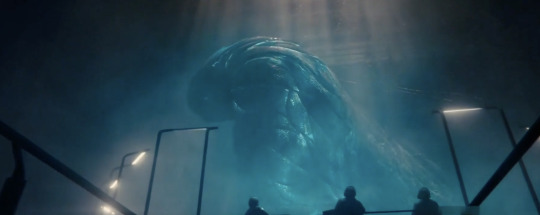
As Toho had done in SHIN GOJIRA, Godzilla’s roars from the various series were employed, as well as his roars from the 2014 film. I was hoping for more of the very deep vocalizations from the 1954 original. Mothra sounded as she always has, with plaintive chirrups and screes. The cries for both Rodan and King Ghidorah were not the originals, and were for me a bit more “generic giant monster” voices. I would have loved to hear new recreations of those readily recognizable Rodan yawps and cackles, and much more forward versions of KG’s triple toned “bidi-bidi-bidi” voice—rather than the faint references buried in the raucous sound design. I rather expected more original Toho monster sounds than were used for both of them, since Daugherty was employing past iconic sounds for both Godzilla and Mothra and seemed to be teasing that during the film’s production.
A Grim Setting
While there is some humor—not all of it apt— intended to break tension, the plot of this film builds upon the global revelation to the people of Earth that past super species were essentially their “gods,” knocking present day humans down a few notches on the dominance pyramid. The context is alarm and terror, though the MONSTERVERSE also offers awe and wonder as viewed through some of those studying the returning Titans. Serizawa remarks in a senate hearing that humanity should be viewed as Godzilla’s “pets”—and he means it. He respects “all forms of life” and sees our world as one that must have a balance which is inclusive of its natural organisms, regardless of where we might end up in Nature’s organic tapestry. Over the course of the film, much is learned about the fascinating past history of human societies who lived in harmony with the Titans. Toho implied some of this in their films—Mothra was regularly portrayed as an eternal goddess for the islanders she protected—but here it is made quite explicit and detailed. Godzilla’s temple lair in submerged Atlantis, with gigantic friezes and sculptures honoring him, is surely an enrichment of this ongoing saga. There is a dark side to this scenario wherein some see humans as being abusive to their world and thus in need of being forcibly “tamed,” and then there is the collective might of the military who want to subjugate these creatures and restore man’s preeminence—behavior that began in the original GOJIRA and sustained throughout most of the films.
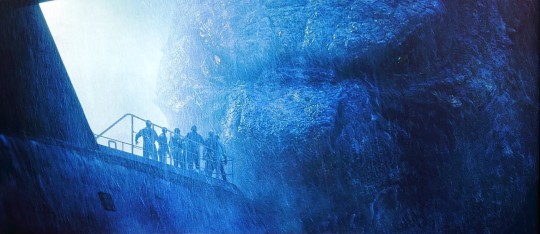
Dr. Emma Russell is an oddly polarized primary character. To begin, she seems a concerned mother who has rescued her daughter Madison from her husband’s descent into alcoholism, which had been incited by the death of their son Andrew during Godzilla’s San Francisco battle with the Muto’s. An aside: That plot aspect is reminiscent of a similar character motivation in the third of Kaneko’s Gamera trilogy, wherein a young girl’s commitment to invoking the destructive daikaiju Iris is sealed by her parents’ collateral death during a monster rampage in the first film where Gamera, an Earth defender, destroys his adversary Gyaos. That Emma is no “mother of the year” is quickly exposed when Allan Jonah’s eco-terrorists arrive to snatch she and her daughter (and her Titan controlling ORCA device) after they execute the innocent MONARCH crew studying Titanus Mosura. Emma has indoctrinated her daughter to comply with her pursuit of shattering mankind’s toxic presence by releasing the Titans as “antibodies” to the virus that is human kind. And Emma is in cahoots with these extremists, her obsession being the first cause setting in motion the slaughter of her MONARCH colleagues in China, Antarctica, and Mexico as well as the other locations wherein the Titans are roused to destroy their containment facilities. And countless others then perish around the globe as the revived Titans rage. The script makes her somewhat sympathetic as a mother—she is shown to love and be concerned with her daughter and mournful of her son—but one could not give her a pass for the oceans of blood on her hands. Nor should she be forgiven for making Madison a victim of Stockholm syndrome. Madison, comprehending the grievous practices kindled by her mother’s theories, does awaken to reject Emma’s deeds and then she strives at great risk to use the ORCA to solve the global catastrophe wrought by both Emma and Jonah’s fanaticism. There is a cut scene in the video release of Madison training with the eco-terrorists which would have underlined her submission to her situation—I would have included that for the parallel with Patty Hearst it presents. Madison ultimately is heroic, and her father Mark renews himself by stepping-up to guide MONARCH’s efforts to understand and control the Titans. He provides some crucial insights based on his knowledge of animal hierarchy and behavior. Ultimately, Emma seeks atonement through her sacrifice, which brings some justice to her character’s story, while Mark and Madison are reunited in a world reeling from cataclysmic destruction. A rather “heavy” arc to this family’s journey, and properly symbolic in dealing with present social concerns. I think that it seemed to be missed by many viewers who were more concerned with the pyrotechnics of the battling Titans, but for me it is a properly grounded human story which offers a grave context to the monster spectacles.

Homages A Plenty
There are so very many references in this film, both visually and via dialogue—“Easter eggs” abound! I’ll touch upon a very few, leaving exhaustingly listing them to other obsessive fans. I enjoyed the numbered MONARCH outposts having significance—the release year of the film in which the Toho daikaiju there contained was a delight and also the fun nod to THE THING in the Antarctica outpost numerical designation. Modernizing the Shobijin by having Doctors Chen and Ling, and generations of twins in their family, as “priestesses” of Mothra is an excellent touch. The new Titans are gleeful references to mythology and cryptozoology, demonstrating that many cultures have embraced daikaiju throughout history. Intriguing archaeological mysteries are touched upon such as 12,000 year old Göbekli Tepe, hinting at past humans dealings with Titans. Even an article in the jam-packed end titles is authored by Steve Martin, the character played by Raymond Burr in the American version of the 1954 film which was first to be titled GODZILLA, KING OF THE MONSTERS.
MONARCH’s mission critical submarine is named USS Scorpion, after an American nuclear submarine which was lost under mysterious circumstances, and it has a Captain Crane, like The Seaview in VOYAGE TO THE BOTTOM OF THE SEA. Its conning tower likewise has Seaview-esque planes and shape. The skeleton of Anguirus has a cameo, briefly glimpsed outside of Godzilla’s temple lair, and if only we’d gotten a better look at more of the Atlantean art paying homage to Godzilla—there seem to be monumental figures with Godzilla heads atop humanoid bodies holding some sort of ceremonial weapons which Serizawa passes on his way to revive his “old friend.” A sculpture of Pazuzu is glimpsed atop a step pyramid in that lost city—such artifacts all sadly obliterated to revive Godzilla. Some more time to drink in this elaborately detailed majestic setting would have been appreciated.

Several key plot events here are reshufflings from past Godzilla films. The concept of one daikaiju sacrificing itself to revive another was pivotal in GODZILLA VS. MECHAGODZILLA 2. There, Godzilla is tortured to near death by electrodes from Mechagodzilla which pierced his body and fried his secondary enlarged ganglial areas. Fire Rodan, nearly expired from his conflict with Mechagodzilla, as a dying act drapes himself atop the fallen Godzilla, evaporating into a sparkling mist and then both healing and resurrecting Godzilla, who now has an even more powerful, red-tinged plasma beam. In GMK, Godzilla is the “heel” who fights the more positive trio of Baragon, Mothra and King Ghidorah. Godzilla seemingly kills King Ghidorah, so Mothra makes a direct, suicidal flight at Godzilla who evaporates her with his plasma breath—shared imagery with Daugherty’s film, though here King Ghidorah and Godzilla have reversed roles. In Kaneko’s film, Mothra’s energy descends upon King Ghidorah in a sparkling cloud, reviving him and enhancing his wings and gravity beams for the final combat with Godzilla. That Godzilla thrives on exposure to radiation has long been part of the basic lore of many of the films, and his revival and enhancement through extreme exposure was no surprise as being primary to the MONSTERVERSE’s mythology. And the scene wherein King Ghidorah “powers-up” via biting electrical cables in the Boston battle reminds me of Kong being electrically revived in the original KING KONG VS. GODZILLA. Godzilla’s expression as King Ghidorah takes that bite, and then the massive arcs of electricity that spread out from his wings to clear the attacking human’s jets are both such memorable moments—which could have been given just a bit more time to accommodate earned “oohs and aahs.”

The novelization of GODZILLA: KING OF THE MONSTERS goes into detail about some of the Titans only glimpsed or simply listed in the film, and one hopes they’ll emerge in the next or further MONSTERVERSE installments—if any. There is a beautiful, brief passage in the book which is told from Godzilla’s point of view. We see through his eyes his responsibility as the lord and protector of this world—the globe is his domain and he is aware of the entire planet, sensing time passing through the shifts in Earth’s tectonic plates. He is aware of the much younger Kong, but unconcerned as Kong is only responsible for Skull Island. We know Kong is the last of his kind, and Godzilla also seems to be as well, though in the comic prequel to this film the story of the Godzilla-esque skeleton infested with the two Muto spores was explained as being Dagon—perhaps his elder “cousin”? The Muto which killed him was vanquished by Godzilla between the 2014 and 2019 films in that comic, which also serves to explain the change in his dorsal plates, which Dougherty has said are continually growing, like antlers. It would be a delight if the Kraken, snoozing as it embraces a sunken nuclear submarine, and Mokele-Mbembe, designed according to the legends as part serpent and elephant, had scenes in the films to come. If Godzilla at some point must sacrifice himself to save the world, discovering another younger member of his species in the Hollow Earth regions would not be surprising and would also embrace that “son of Godzilla” concept used in Toho’s series. The sunken Atlantis being part of the subterranean world evokes Verne’s JOURNEY TO THE CENTER OF THE EARTH, and of course the 1959 film adaptation concludes with a gigantic lizard menacing the remains of the Lindenbrook party in its ruins. Perhaps there are other humans (humanoids) “down below” as well, in fascinating antediluvian cities, much as Toho posited with the Seatopians, or even like the subterranean Sumerians from THE MOLE PEOPLE? Possibilities abound!
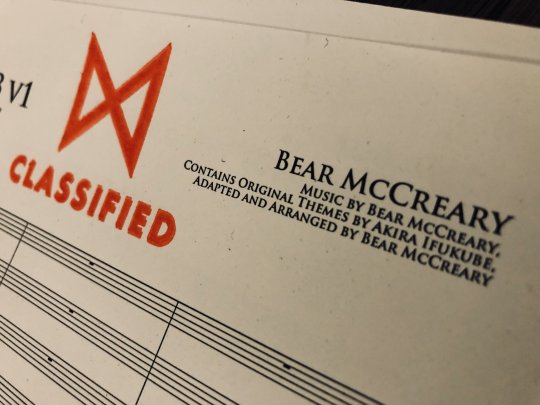
The Score
We’ve been quite fortunate that the scores for Hollywood Godzilla films have been powerful, thematic, and thoughtfully composed works wrought by talented composers. Both Arnold and Desplat crafted magnificent music that expressively carried the action. McCreary’s is the first MONSTERVERSE score to incorporate iconic themes for both Godzilla and Mothra from the Toho scores, and these quotations were well-timed and heightened the drama. Additionally, his new themes are both strong and memorable. The thematic material for King Ghidorah constantly iterates the number three, and the general rising melodic line is even kin to that of Holst’s “Mars, The Bringer of War” from THE PLANETS. The chanting monks’ voices offer a mysterious sense of religious awe to support the diabolical “destroyer of worlds.” Rodan’s theme features whooping horns, as if to echo the “Samurai of the Skies” cries. Even the film’s opening quiet theme has that “Go-Ji-Ra” rhythm that was used in both the 1998 and 2014 films to craft memorable new musical signatures for the King of the Monsters. Most touching was the gorgeous choral music accompanying Serizawa’s Spock-esque sacrifice—which even visually rhymed the descent of the mini-sub with the photon torpedo casket sequence from THE WRATH OF KHAN. The MONSTERVERSE’s Serizawa is essentially a transmogrified Dr. Yamane from the 1954 GOJIRA, a man who studies and appreciates Godzilla as a living being. By having him sacrifice himself not to destroy Earth’s dominant Titan, but to revive him with a nuclear weapon and thus save humanity, works as a pragmatic inverse linking him to the original Dr. Seizawa, the self-immolating physicist who conceived of far too deadly a weapon in the Oxygen Destroyer. McCreary’s “requiem” suited that sequence to perfection. When Godzilla rises again and blasts forth his plasma beam into the sky, the Ifukube-based accompaniment was deeply moving, and the moment Godzilla looked to his human saviors was delightful. He seems to acknowledge their role, much as that of the people from a past civilization who had idolized him, and the soundtrack even has a fleeting phrase of Ifukube’s Godzilla theme much as it was scored for high woodwinds in the requiem from GODZILLA VS. DESTOROYAH—a very brief and subtle nod. McCreary’s triumphant symphonic apotheosis of his own opening Go-ji-ra theme over that concluding acknowledgment of the Earth’s true monarch brought me chills. Being followed immediately by McCreary’s magnificently over-the-top arrangement of B.O.C.’s song “Godzilla” to commence the end titles was fan service of the highest order. Its refrain, “History shows again and again how nature points out the folly of man!” is of course the underlying theme of the Legendary MONSTERVERSE. “Bravo!” Maestro McCreary!
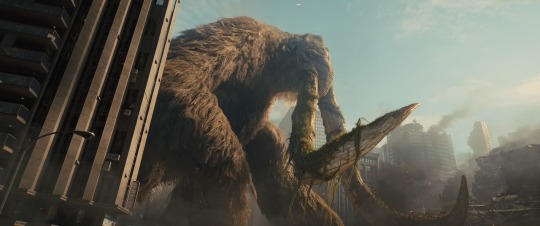
Could Be Bettered
Some minor cavils. I prefer to hear the word Ghidorah pronounced in the more euphonious Japanese manner, with the three syllables (ghi-do-rah) given equal emphasis and the first one slightly higher in pitch. One can hear it when watching Toho’s original Japanese prints with English subtitles. Americans emphasize the second syllable (Ghi-DOR-ah), and thus the middle one sounds like the English word door, while the Japanese put the R on the third syllable. I’d have dropped that weak gonorrhea joke, and the “very long fortune cookie” line was a tad clumsy, and a bit out of place for the dignified Serizawa. In this film he seems to take a bit of a back seat to Dr. Mark Russell, once he’s on the scene, which is a bit of a disservice to his character for me. And that his sidekick Dr. Graham is so quickly dispatched by King Ghidorah during his emergence seemed a bit too casual—her character was a fine one, and I’d have enjoyed more from her going forward.
The film brings back the Oxygen Destroyer, a wonderful nod to the original, and they hint at it being tested in the news crawl Madison and Emma have on in the background in their opening domestic scene at the China base. The news commentator’s reporting of “mass die-offs” must be from the military testing it. Rather than having it come as a surprise announcement when the incoming missile is announced by Admiral Stenz, I think that viewers should have been clued-in earlier, and rather easily. The audience primarily sees things from the point of view of the MONARCH characters. But if we go to that senate hearing scene, from which the MONARCH crew departs having been alerted to the eco-terrorist attack on their Mothra temple base—despite being warned that there will be consequences, that scene could have briefly continued. Admiral Stenz would reveal to the committee, once Serizawa and crew have departed, that the military now has a prototype weapon that they think could be used to exterminate the Titans. We’d cut from the blurred footage of the Mutos on the monitor to a graphic of the Oxygen Destroyer (what we saw later when Stenz alerts the Argo team), while Stenz declares this is their tested proposal for conquering the Titans. If one wanted to flesh it out, then perhaps running some brief footage of it killing fish or other forms of life with some dark accompanying music would be a strong punctuation. But even that wouldn’t be required, just that graphic and a Stenz voiceover would have done the trick. So, rather than ending on a weak joke about blurred Titan genitals, we’d have the Oxygen Destroyer’s revelation as added tension for its eventual use.
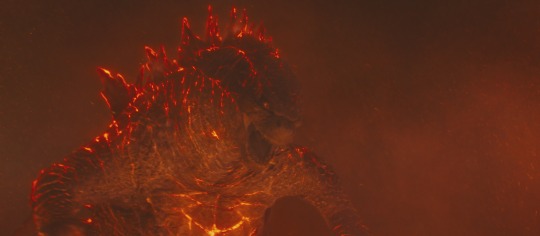
With such wonderfully detailed renditions of the Titans, particularly the four Toho guest stars, I think they went a bit too far in trying to fit them into their environments by surrounding them with clouds, mists, and fog. This gives the Titan scenes an overall soft and painterly feel, and I can enjoy that aesthetic choice, but seeing the creatures that were so very carefully designed, and whose movements are crafted in such a convincing manner, being obscured far too often I think was an error. Dialing that back somewhat would have been a wiser choice—show us what you’ve got! Particularly in the expert choreography of the battling Titans—which in some scenes appears to have been inspired by Matt Frank’s compositional style—being able to see how the tussles and tumbles progress with greater clarity would have enhanced the viewing experience.
Wishful Thinking
I would hope that there might eventually be a “director’s cut” in some future boxed-set home video release of the MONSTERVERSE films that would relax the pace of this film somewhat—taking time to linger on the beautifully crafted images so that we won’t have to freeze-frame to savor the glories on screen. And the storyboarded but unfilmed mid-credit scene of another Mothra egg being sung to by twin young girls in another hidden temple space beneath a modern city should be added-in or at least exist as part of the extras—possibly an animated version? If the box office returns from the next installment don’t justify further live action films, it would be fun to have a MONARCH-centered animated series exploring the numerous Titans and how humanity must deal with them. The cartoon series that followed the 1998 Emmerich GODZILLA film was quite an improvement over its progenitor, so I suspect something similar could happen with this franchise going forward once live action films are no longer produced.
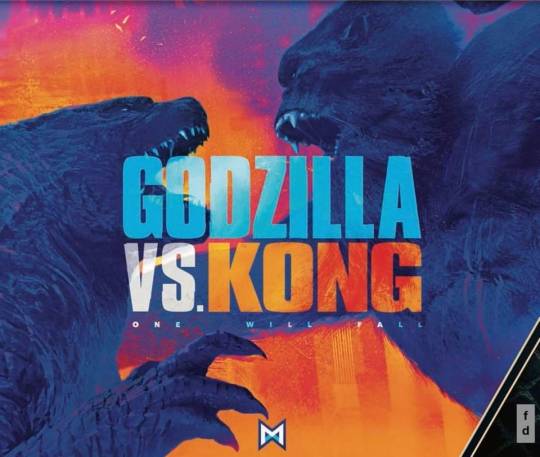
The Coming Conflict
Daugherty has reportedly had some plot input towards Wingard’s upcoming GODZILLA VS. KONG, and so the end titles give us glimpses into what might be to come via various briefly shown illustrated articles. One explains that the newly emerged Titans were being drawn to Skull Island, so one has to wonder if that locale could at the conclusion become the “Monster Island” of the MONSTERVERSE? That it is a gateway to the Hollow Earth is an exciting prospect, for more mysteries abound there. Already the rumor that the APEX corporation, which funded Colonel Alan Jonah’s eco-terrorists, is now behind the construction of Mechagodzilla (the toys of this character have been leaked already), who will have an ORCA variant built-in to lure Titans to the slaughter.
King Ghidorah can regenerate in an unearthly manner and the director has mentioned in interviews that his consciousness is spread through his body. Daugherty has said that whatever might have fed on the carcass head could perhaps become some sort of mutating “legion,” perpetuating King Ghidorah, from flies to any sea creatures that took a nibble, if the series goes on. The rumor mill suggests that materials from the brain of this dead head have been used to create a bio-tech controller to enhance Mechagodzilla. Now that we’ve gone to a Showa series sensibility, the film makers have a great deal of latitude for referencing some of the more fantastic concepts from earlier films. With the biggest blockbusters today being super hero fantasies, one need not try to pretend that MONSTERVERSE films are bounded by the laws of our Universe. The relatively more “realist” approach of Edwards’ 2014 GODZILLA has been evolved into a broadly fantastic approach, which reflects much of what Toho had done in all of its series.
Fan Reactions
It seems some Godzilla fans on message boards are now turning on Dougherty’s epic—everyone seems to want each new film to be their vision of the perfect Godzilla film and then disappointment sets in when it isn’t. Yet so many of the films throughout the ongoing saga of Godzilla have been silly, cheesy, daffy, and sometimes just dopey—yet many of we aficionados embrace them all for their charms, after all, we get to see more of Godzilla and his fellow daikaiju. They appeal to quite a wide range of viewers of all ages, and as one ages, different films might head a favorites list based on one’s evolving tastes. Better that more Godzilla tales are wrought and released, regardless of whatever flaws we might find. In GODZILLA: KING OF THE MONSTERS the incarnations of our old favorites and some intriguing new Titans are truly extraordinary, brought to vivid life with contemporary effects capabilities. Never before have these sorts of films been graced with such mammoth budgets and been seen by such large audiences around the globe—a golden age for Godzilla is upon us.
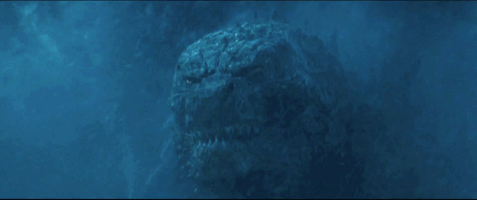
Huzzah Daugherty!
Despite its flaws, I find so much to love in this film, particularly that final scene. After Godzilla has vaporized his age-old rival and literally “smoked” his final head, the Titans summoned by Madison’s activation of the ORCA in Fenway Park arrive. Godzilla, battered and weary from his strivings has exhausted the energy gifted to him through his ally Mothra’s sacrifice—like Heracles after his many labors. This unbowed victor is at last confronted by the other awakened super-species. It looks like a further battle could ensue, as Rodan swoops down at last. But, that canny firebird knows his place and thus submits to the true king, with a nod and almost a courtsey-like gesture of his cape-like wings. The other Titans then “bend the knee” and Godzilla bellows his triumphant “skreeonk” as McCreary’s music superbly supports this coronation scene. I felt such a powerful frisson at that moment and do with each repeat viewing. The Titans demonstrate their consciousness, intelligence, and their sense of natural hierarchy in what is one of my favorite conclusions in the entire canon of Godzilla films.
So, I salute Daugherty and all the others involved in what for me is a grand outing for all of the Titans and a very fine addition to the roster of Godzilla’s adventures. I’ve watched it many times since I saw that first Thursday night preview screening, and I continue to enjoy it immensely. Like all of the earlier films, I don’t dwell on what I see as flaws, but I celebrate the unique wonders that have been wrought, and these abound in this Toho-redolent GODZILLA: KING OF THE MONSTERS.
The bar has been raised. Batter-up, Adam Wingard—let the MONSTERVERSE continue!
—Peter H. Gilmore
19 notes
·
View notes
Photo

In Memoriam Christopher Rouse (1949-2019)
I consider Dr. Christopher Rouse to be one of the great symphonists of our time, and I’ve been following his exquisitely dark and expressive compositions since I discovered his earlier orchestral works GORGON and The Infernal Machine. I recall him commenting in program notes that so much contemporary music had lost the ability to work in a true “allegro” tempo, so he deftly remedied that in several of his pieces. He’s also a master of “adagio” tempi and everything in between. It was always exciting for me when his new works were performed and released—I knew that something of value awaited my listening.
His symphonies demonstrate a profound awareness of this art form, both in responding to great works of the past and crafting powerful new sayings in this sublime genre. He completed his Symphony No. 6, which will be premiered October 18th by the Cincinnati Symphony Orchestra conducted by Louis Langrée, and it is modeled after Mahler’s valedictory 9th. Prior to his passing, Rouse said of this new work: “There’s a tragic quality to this piece, and I’m sorry to frustrate people by not saying what it is or why it is.” I suspect we’ve now learned the answer to that mysterious statement.
Rouse also wrote a number of concerti which find intriguing ways to highlight a solo instrumentalist within an orchestral fabric. I was fortunate to attend the premiere of his Trombone Concerto in Manhattan, dedicated to the memory of Leonard Bernstein, which later was awarded a Pulitzer Prize.
His monumental Requiem inspired by the events of 9/11 may be his greatest piece—lasting close to 90 minutes. Unfortunately, it has yet to be released as a commercial recording, possibly his passing might prompt the remedying of this oversight.
I trust that anyone who enjoys intelligently crafted, challenging orchestral music that ranges from the terrifying to the elegiac might spend some time exploring Rouse’s music. I’m confident his works will stand with those of other great composers as the years pass—his art will surely move appreciative listeners far into the future.
Hail Christopher Rouse!
—Magus Peter H. Gilmore
youtube
#Christopher Rouse#symphonist#20th century classical music#contemporary composer#21st century classical music#gorgon#infernal machine#trombone concerto#symphony
4 notes
·
View notes
Photo
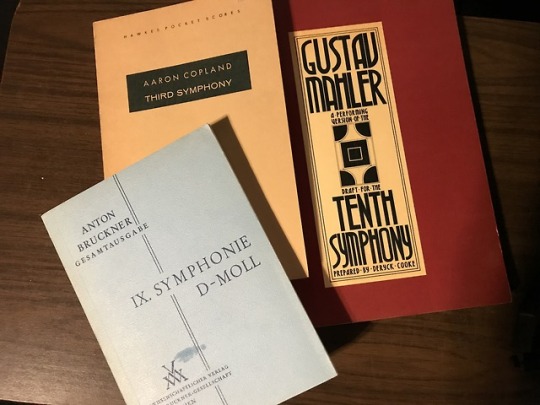
VOX SATANAE EPISODE #400, PARTS 1 & 2
Magister Gene Lavergne honored me by having me on as his guest co-host for the mammoth 400th episode of his classical music podcast, Vox Satanae. Our discussion explores dark emotional narratives as found in two operas, three symphonies and a film score which in part was derived from a concert work.
We begin with excerpts from Richard Strauss’ ELEKTRA, in which the lead character’s drive for vengeance brought Strauss to the heights of dissonance and cacophony found in his works. This is followed by Bartók’s BLUEBEARD’S CASTLE, in which the brooding, murderous Bluebeard welcomes his inquisitive new wife Judith to explore his domains—both architectural and psychological. We conclude the first part with the final minutes of the Adagio from Bruckner’s Symphony No. 9 in which a dissonant “crisis chord” shatters the movement and leads to a consolation that is often used to conclude the work, even though there has been an excellent speculative version of the finale that ultimately brings the long-sought and well-deserved transfiguration desired by the composer.
The second part begins with Mahler’s 10th Symphony, as completed by Deryck Cooke, which in part concretizes the composer’s struggle to deal with conflicts in his marriage as he worked to move past the farewells he offered in both Das Lied von der Erde and his 9th Symphony. It too contains a powerful “crisis chord” in both the opening and finale movements. We move on to Bernard Herrmann’s 1936 composition, a Sinfonietta for strings, parts of which he employed when scoring Hitchcock’s PSYCHO in 1960. We listen to the version of the Sinfonietta from 1975 as well as a suite of cues from the film score. We end with the Symphony No. 3 by Aaron Copland in a recent recording by Leonard Slatkin and the Detroit Symphony Orchestra which performs the originally published version that includes parts of the finale which had been cut at Leonard Bernstein’s instigation. Interestingly, Herrmann was part of Copland’s American composers group around the time he wrote his Sinfonietta, which seems inspired by works of Schoenberg and Berg, who were disciples of Mahler. Copland’s final symphony was a summation of his compositional prowess and one can hear some Mahler influences—again a powerful “crisis chord” halts the fourth movement before moving on to a triumphant peroration which intertwines the Fanfare for the Common Man, which initiates and permeates the finale, with the main theme from the first movement.
Our listening journey brings us through very dark emotional landscapes to the final grandeur that Copland so deftly captures in what is a splendid and monumental symphony. I trust you might spend some time listening to our discussion and being as moved as we are by these extraordinary compositions.
—Peter H. Gilmore
Vox Satanae Episode 400 Part 1
Vox Satanae Episode 400 Part 2
#vox satanae#richard strauss#elektra opera#bartok#anton bruckner#gustav mahler#bernard herrmann#psycho#aaron copland#classical music#opera#classical instrumental music#symphony
15 notes
·
View notes
Photo
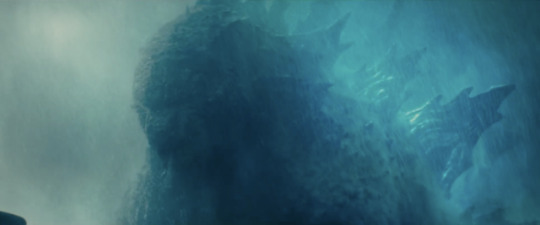
LONG LIVE THE KING!
Today, the first trailer was released for Michael Dougherty’s GODZILLA: KING OF THE MONSTERS, due May 31st of 2019—sequel to Gareth Edward’s powerful 2014 GODZILLA. Every Godzilla fan I know was eagerly awaiting this event, and the reaction has been extraordinarily affirmative. Dougherty is delivering an apocalyptic vision wherein the daikaiju (now called Titans) are returning to dominate the globe and expunge humanity.
Being a hyper-obsessed aficionado (or more colloquially, Godzilla nerd), I did a frame-by-frame look through the trailer and noted a sequence in a Sumerian sort of city in a cavern into which magma is dripping. It looks like one of Bob Eggleton’s riffs on past great fantasist artists, and the astute will note a statue of Pazuzu, that ancient demon, atop one of the structures of the necropolis.

The screen capture of Godzilla rising from the sea I use to head this article also seems Eggleton-esque (I would suspect Dougherty is a fan of his exquisite work). Earlier, we see Serizawa moving through the sunken part of this city in a submersible, observing bas reliefs of people worshipping Godzilla which seem inspired by imagery from Lovecraft’s CALL OF CTHULHU—R’lyeh seems the intended evocation.
We are gifted glimpses of the major Toho monsters. Mothra is seen as an endearing larvae and eerily numinous imago. Rodan appears as a form of Firebird (Thunderbird/Quetzalcoatl/Phoenix). Like Toho’s ‘90s Fire Rodan, he’s energized and extraordinarily destructive. King Ghidorah is glimpsed frozen in ice and as a vast shadow, spreading his wings like a vampiric cloak in Satanic splendor like Chernabog in FANTASIA. Godzilla himself has some tweaks, primary clear is that his tail seems thickened at the tip and his dorsal plates are larger than in 2014, referencing the jagged shapes of the original GOJIRA. I wonder if the sauropod-styled feet have been slightly modded as well?
As you’ll see when you click on the link below and watch the trailer, Emma Russell (Vera Farmiga) is addressing what I assume to be her former colleagues in a speech explaining her reasons for her extreme actions, indicating that she considers humanity a plague to the Earth, which has conjured forth once again its giant monsters to eliminate. She’s worked for Monarch, the agency that had for decades been monitoring the dormant (and not so dormant) ancient species. It seems here she’s betrayed them. There’s a glimpse of a photo on the mantle of Russell’s family, she, her husband and two children, but I surmise one of the children perishes in a way caused by humanity’s harmful activities to the ecology of the planet. Her surviving daughter, Madison (Millie Bobby Brown), is shown displaying a psychic connection to the Mothra larvae, accompanied by her mother.
It seems that Russell contrives to release both Rodan and Ghidorah so that they can lay waste to human civilization and her estranged husband Mark (Kyle Chandler) protests her freeing the toxic Titans. Godzilla it seems might be deeply hurt (perhaps from his battles in the previous film or from a conflict with either Rodan or King Ghidorah in the earlier parts of this film) and has retreated to that ancient submerged semi-Sumerian city where he was worshipped. Dr. Serizawa apparently leads a suicide mission to deliver a nuke to resurrect Godzilla, so that he can combat King Ghidorah and Rodan, aided and abetted by Mothra, now emerged from her cocoon and bonded with Madison. We see glimpses of Serizawa climbing up a step pyramid which earlier in the trailer is shown exploding as magma oozes into the cavern in which it lies. Madison seems to triumphantly summon Mothra, who in turn has brought Godzilla to the fray, as squadrons of jets support him.
I’m speculating above, based on the fragments of the trailer and so I cannot say how this will end, and I might have misread some of the imagery, but I expect that we’ll get a post credit sequence with some reference to Kong, since he’ll be mixing it up with Godzilla in the film to follow in 2020. The use of Debussy’s “Claire de Lune” in an arrangement that surges to volume levels matching the imagery was an inspired choice as underscore. That Bear McCreary has been announced to be the composer is quite pleasing to me, as I first came to enjoy his work in the revived BATTLESTAR GALACTICA and particularly like his Hermann-esque score for 10 CLOVERFIELD LANE. And Dougherty has said that some of Ifukube’s iconic themes will be incorporated into McCreary’s score, and also that we might expect cameos of other classic daikaiju. All great news!
My 61st birthday will be a week before this film’s release, so it will be a truly delightful belated gift for my celebration. I trust you’ll enjoy the trailer as much as I do and look forward to Legendary’s presenting of the ongoing reign of the King of the Monsters!
—Peter H. Gilmore
youtube
#godzilla king of the monsters#Godzilla#rodan#mothra#king ghidorah#king kong#michael dougherty#Toho Studios#daikaiju#kaiju
25 notes
·
View notes
Photo
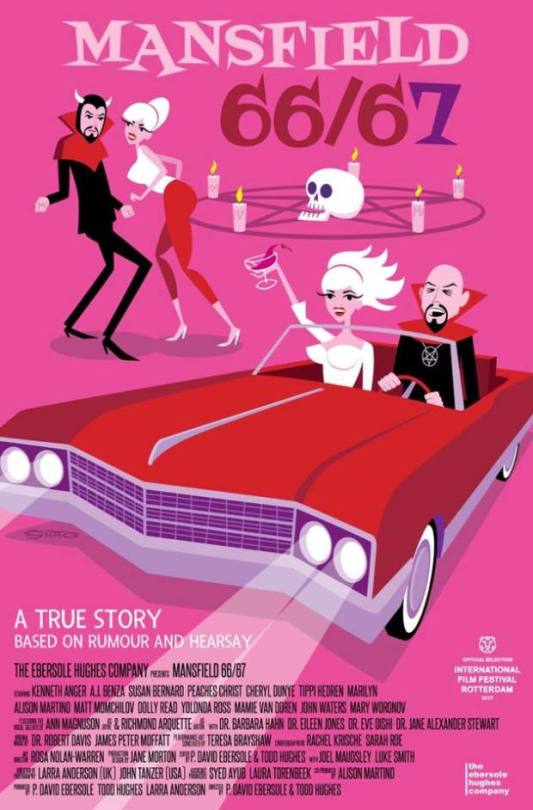
The Missed Opportunity of MANSFIELD 66/67
In hope of drumming up some positive commentary for their upcoming film, the producers of MANSFIELD 66/67 contacted members of the hierarchy of the Church of Satan and gave us an opportunity to view it; sadly, all who watched found it disappointing. MANSFIELD 66/67 not only fails to provide a way to separate fact from the speculations presented—mostly derived from misinformation and sometimes completely baseless—but it also offers a very limited and shallow portrait of the people involved. The story of Anton LaVey and Jayne Mansfield is told essentially from a tabloid perspective meant to excite and titillate the uninformed, and does not move beyond that. While having John Waters, one of many talking heads, state that a pack of lies can be readily presented after one’s death (hint, hint), and the opening text stating that this is not to be considered factual, that it actually is such a collection of distorted material makes finding any of the few nuggets of insight practically impossible for anyone not already well-informed on the subjects. I had members send me their reviews which were very frank as well as withering and scathing, but I’m not going to quote from those. But I can assure you that this amateurish flick won’t appeal to people who value Anton LaVey based on his writings and philosophy. I found that the filmmakers set out to present both Mansfield and LaVey as camp and “cheesy”—and as a fan of “bad” films I understand that. But both Mansfield and LaVey were vivid individuals whose lives embraced much more. I did not know Jayne, but I did know Dr. LaVey well, so my personal knowledge and appreciation for his perspective is one enjoyed by few. He spoke of Jayne as a woman who was quite intelligent and deeply carnal. Her initial contact with Satanism as a means for self-publicity lead her to many philosophical discussions with LaVey as she felt his carnal philosophy enabled her to appreciate all aspects of her personality. She called Satanism “Khalil Gibran with balls” and enjoyed LaVey as a mentor who accepted her as-is, and not another opportunistic Svengali trying to shape her into some unreachable ideal. In 1966 through 1967, LaVey was becoming a writer and developing his philosophy as well as growing the Church of Satan. His early “deviltry” was meant as an attention-getter, but was also done tongue-in-cheek. He soon reached a point wherein he felt that the “stuffed rat and tombstone” approach was done and wanted his philosophy and organization to be taken seriously. The portrait in this film does an injustice to the man who wrote four books—all of which remain in print and selling well 20 years after his demise—and who founded a continually growing religion with worldwide adherents, offering a vital philosophy used by thousands of people to find satisfaction. Many of those interviewed clearly knew little about the subjects. John Waters, whose films and writings I admire, said the most insulting thing when he jokingly brought up the idea of goat sacrifices. Now, Satanists love a good joke, but since we were the victims of an actual “Satanic Panic” wherein Christian evangelists successfully sold the media on the idea that there was a global network of “satanic cultists” killing animals and babies—something I spent many hours debunking in the late 80s and through the 90s in audio, print and video media—that’s not something we Satanists find funny. Thus, another person glibly stating that ROSEMARY’S BABY launched a “satanic panic” in films cheapened the term used for something that we take seriously—during this hysteria, there was even a bill floated in Congress to make Satanism illegal. That film and the novel from which it was expertly adapted by Polansky created a trend, but devil-themed films had been made before and have continued to be made, since Satan always sells. The referencing of THE BLACK CAT and EYE OF THE DEVIL were appropriate, but no worthwhile comments were made about these films, both of which were prior to ROSEMARY’S BABY and thus undercut that “satanic panic” comment. In fact, Ira Levin was sufficiently influenced by the press accounts of LaVey and the Church of Satan that he incorporated aspects from the articles he read in his book, and then had the publicists for both book and film contact LaVey to get his help in promoting them. The publicists created a press release wherein they suggested that LaVey possibly played “The Devil” in the film and asked him to go along with it—and he did. Some other points. In the Church of Satan we state “Satanism demands study, not worship.” Well, if that “Satanism Scholar” had ever taken a class in the history and practices of Satanism from us, his segments in MANSFIELD 66/67 would have earned him a C-. Also, those inept choral and dance sequences were just disruptive and amateurish, and while some might find them to be amusing in their shoddiness, the comment they seem to make is that this is all the subjects of the film deserve—a sort of clunky, graceless “greek chorus.” While Kenneth Anger was the only person to be interviewed who knew LaVey—and they were friends for decades—Anger has apparently become quite bitter since LaVey’s passing as he’s often contacted not about his own body of films and writing, but about LaVey. His statement that the “Church of Satan died with LaVey” is simply sour grapes on his part. Of course, this film’s publicists wouldn’t have contacted us if that were true, but with such a statement in the film, giving it any sort of support becomes a moot point, even if any of us did find it of overall value—which we didn’t. I enjoyed the brief footage of Tippi Hedren speaking about Togare as I hadn’t seen that before, though I’d heard that story directly from Anton LaVey. I’m glad the filmmakers used bits of The Brother Buzz Show, which demonstrated that Togare was quite a sensation in San Francisco before LaVey founded the Church of Satan. Benza covered the point that curses are a psychological, not a supernatural, form of retaliation, and others supported that understanding which is a good point about how ritual magic is employed in the Church of Satan—for psychological effect, not worship. But it struck me as strange that there was no mention of Diane Hegarty, who was LaVey’s companion and mother of his second daughter. She was with him as the High Priestess of the Church of Satan and had to deal with Jayne’s intrusion into their lives. The poster for the film is retro-cute, but showing LaVey dancing with Jayne is indeed fantasy as LaVey himself never danced—he liked to watch ladies dance, but he’d rather be playing the music which moved them. I’ve gone on at length as I wanted to be clear regarding how this film struck me and why I do not offer any endorsement. My thoughts were shared with the filmmakers so they are well aware that their work was deeply disappointing to the members of the Church of Satan who took their time to watch it. And it seems that the folks who made this feel they are celebrating both LaVey and Mansfield in ways they find amusing or attractive and they hope others might share in that. But where Anton LaVey is concerned, for me this focused on a brief time in his life without offering any real insights into a very fascinating fellow who later accomplished a great deal, particularly in his championing of sexual freedom for all orientations and genders at a time when that was something frowned upon by almost all religions—quite a rare and pioneering attitude for a man born in 1930. That, in addition to busty bombshells, LGTBQ members were embraced as equal in the Church of Satan from its beginning in 1966 is a point not dealt with in any meaningful way in the film.
So, I suggest that MANSFIELD 66/67 is worth avoiding if you’d have to pay for it in any way. Instead, enjoy the poster—the sole aspect of this production with any charms—and imagine your own biopic of the wild and fascinating time LaVey and Mansfield’s lives intersected.
—Magus Peter H. Gilmore
16 notes
·
View notes
Photo

Four Reviews—Kong: Skull Island, Sausage Party, Wonder Woman, Shin Godzilla
KONG: SKULL ISLAND
Legendary’s Monsterverse series gets its second installment, following Gareth Edwards’ somber and successful resurrection of GODZILLA (2014). Director Jordan Vogt-Roberts blends sensibilities from the original KING KONG (1933) with APOCALYPSE NOW and some sly nods to the Conrad novel HEART OF DARKNESS that inspired that indelible war film to skillfully craft an action-packed tour of Kong’s homeland. Here, in a hidden island surrounded by perpetual storms which serves as a graveyard of lost ships, serene, mute indigenous people revere the massive ape as a protector deity. And rightly so, as this adolescent fellow primate lost his parents to the ravening reptilian Skull Crawlers who emerge from the underground world—likely be a plot point for future films in this series.
MONARCH (the secretive government research agency) scientists and military men invade on helicopters and drop bombs to perform seismic surveys, but this rouses Kong to swat them from the sky and provokes the arrival of the devils from below. Not the typical “beauty and the beast” tale told in the best two prior Kong films—the Cooper original and the Jackson 2005 loving homage to it—this one brings mankind up against creatures whose god-like size and strength question the dominion of our species of this planet, which in the Monsterverse mythology has long been the territory of ancient Daijkaiju.
In an homage to Boorman’s HELL IN THE PACIFIC, the film begins in 1944 with an American and a Japanese pilot crashing on the island. They continue their aerial battle hand to hand, but are halted by the arrival of Kong, who is less a giant gorilla and more an evolutionary step between gorilla and human. John C. Reilly as Lieutenant Hank Marlow steals the film as the aged pilot who has survived almost three decades on that dangerous ground and thus plays a pivotal role in making certain some of the Monarch group can reach the rendezvous point to be rescued. The redoubtable Samuel L. Jackson as Lieutenant Colonel Preston Packard puts on his Ahab boots to avenge his fellow soldiers who befell Kong’s wrath. You can guess how that plays out.
As you would want, there are many fascinating oversized beasts and the humans fare ill in some of their confrontations with them. There are dramatic encounters between Kong and the humans as well as his subterranean enemies and the film concludes with a sweet resolution for Hank, and, post credits, some revelations by the MONARCH survivors revealing the creature cast of the currently filming GODZILLA: KING OF THE MONSTERS directed by Michael Dougherty, due in 2019. Kong will clash with Godzilla in 2020 under the enthusiastic direction of Adam Wingard. I await both with much anticipation!

SAUSAGE PARTY
I was sent this animated film as a gift by a friend who said not a word as to why it had been selected for me. He has an earthy sense of humor and is a talented artist as well as keen observer of the human animal, so I was prepared for something that might embody those aspects to some degree. I was not disappointed! Seth Rogen and his cohorts have crafted a devastating critique of the human foolishness of believing that some form of supernatural entities have their well-being as a primary concern. The various anthropomorphic foodstuffs in the supermarket have faith that the humans who purchase them will be bringing them somewhere better, a “Great Beyond” transcending their current existence on the shelves. But of course in time they learn the truth that being eaten awaits them and that their “gods” are but shabby, shallow, self-absorbed consumers.
Humor is broadly derived from the various ethnic food products conjuring outrageous stereotypes, and no holds are barred in that department—harking back to how such products were once advertised, though without the foul language and sexual behavior included here, making for an R rating. Most amusing for me is the Woody Allen-esque bisexual bagel voiced with manic exuberance by Edward Norton. For secularists not infected by the virus of political correctness, SAUSAGE PARTY is a ribald, raunchy hilarious feast. SJW pantywaists afraid of being triggered might want to stay away, as they’ll not find a safe space here.

WONDER WOMAN
The origin tale of Diana Prince, daughter of Zeus, is told with the proper amount of spectacle, humor, and gravity by Patty Jenkins and the eponymous character portayed with elegance and strength by Gal Gadot. Set during World War I, the visuals of the normal humans’ struggle are depicted in sepia tones shot through with fire, while Diana’s sheltered Themyscira is a lush, colorful island retreat with sophisticated art and architecture. There seemed to me a bit of a callback to Lucy Lawless’ Xena, Warrior Princess in the garb and martial techniques employed by the women of this hidden land.
What struck me as wonderfully Satanic is the philosophical outcome of this journey. Diana leaves her island as an idealist, holding love as a primary value and she has a rather simplistic view of her mission. In the course of her conflict with her brother Ares, who proclaims he is not the god of war, but of truth, he reveals to her the venality and mindless hatred of humanity in the global conflict he has cultivated. Diana witnesses horrors that are not simply conjured by Ares, but which are part of human nature. Yet the love she shares with Captain Steve Trevor—a charming Chris Pine—and his ultimate heroic sacrifice show her a broader range of human capabilities. Before dispatching Ares, as her father intended, Diana declares her embrace of humanity now with a full grasp of its spectrum of faults and glories—a third side perspective that we Satanists have proclaimed since Anton LaVey founded our philosophy in 1966. This is certainly one of the better DC films and should entertain those who enjoy these comic-derived larger-than-life beings as an embodiment of our propensity for embracing inspirational heroic mythology.

SHIN GOJIRA (SHIN GODZILLA / GODZILLA RESURGENCE)
While Edwards’ GODZILLA was in production, Toho hedged their bets by developing a live action GOJIRA film under the guidance of Hideaki Anno and Shinji Higuchi, both fans and skilled contributors to Japanese fantastic cinema. Legendary had contracted to do three Godzilla films, but apparently because they delayed the sequel to the 2014 film, ostensibly waiting for Edwards to complete ROGUE ONE, Toho completed and released their live-action film in 2016, SHIN GOJIRA. Much like Kaneko’s wonderful one-off 2001 film, GODZILLA, MOTHRA, KING GHIDORAH: DAIKAJI SOKOUGEKI, this is an original take on Gojira that has no links to the other films Toho produced in its three prior series.
Anno wrote and directed and he’s known for the high weirdness of NEON GENESIS EVANGELION, so with Higuchi handling the SPFX (he did masterful work for Kaneko’s 90s GAMERA trilogy) this duo has wrought a political satire depicting governmental hesitancy to deal with the threat of a constantly evolving giant monster rising from the sea to lay waste to Japan. For the Japanese who have in recent memory dealt with tidal waves, earthquakes and the Fukushima disaster, they fully grasp this mockery of their own government.
Rather than being some form of prehistoric monster roused by H bomb detonations, this monstrosity is a new life form evolving from a deep sea creature, possibly kin to a frill shark, that consumed nuclear waste dumped on the ocean bottom by the American government. Shin Godzilla—the name loosely implies deity much as the American term for Gojira includes the word God—is first witnessed as a gigantic tail lashing about in Tokyo bay (the first form). When it comes inland via waterways as a slithering, rubbery google-eyed intruder, leaking red fluid from its gill slits (Kamata-kun), the Prime Minister and his cabinet and advisors are continually paralyzed through fear of committing errors that will end their political careers, taking endless, fruitless meetings in numerous governmental chambers. It takes the intervention of Deputy Chief Cabinet Secretary Rando Yaguchi, a maverick who wants to get things done, to assemble a crew of outsiders and misfits who seek to understand and find a way to defeat this threat arising from mutated nature.
Kamata-kun seizes-up at one point, falling to the ground, but rouses to shift itsself into a red-hued, upright standing 50 meter beast (Shinagawa-kun) whose roar is the same as that of the original Gojira, and he’s accompanied by Ifukube’s score for that 1954 film. With glowing red patches surrounding his dorsal fins indicating some sort of overheating, Shinagawa-kun smashes through buildings and dives back into the bay. The hovering military ‘copters had yet to attack, hindered by the Prime Minister’s fear of harming civilians. Yaguchi’s team gathers and analyzes info, aided by a Japanese American beauty who shares secret data from the US authorities whom she represents. And then the full-sized bizarre golem Shin Gojira arises and begins a rampage.
As is traditional, the Japanese military, aided by American stealth bombers, prove ineffectual against this particularly hideous incarnation of Gojira. With a profusion of snuggle-teeth, seemingly sightless eyes, stunted forearms and an insanely long tail, Anno’s vision of a nightmare monster with bizarre powers is well-realized by Higuchi and his team. For the first time Toho went with CGI (aided by some motion capture) to render the majority of the effects and they are primarily very effective. This Gojira is magma-black with glowing red patches from within, much like the Burning Godzilla of 1995. But his wildly overpowered breath weapon, which goes from firestorm to purple laser beam, accompanied by similar bursts from his dorsal plates and mangled tail end are unique to this rendition. The film uses classic Ifukube score excerpts and evocative new music by Shiro Sagisu and even employs sound effects from Toho’s stock library, most dating to the original Showa series of Gojira films (1954-1975).
Under the threat of the US deploying nuclear weapons, Yaguchi rallies his team and they find a means to immobilize Gojira, aided by waves of US drones meant to distract it while attacks by explosive-laden train cars and finally tanker trucks filled with freezing chemicals ultimately cause Gojira to become a colossal statue as part of the Tokyo skyline. The last shot shows us that Gojira was willing forth a fifth form, as humanoid Godzillian beings had begun to emerge from the tip of its tail. This film was immensely successful both critically and financially in Japan, though a possible sequel cannot be released until after Legendary’s films emerge. However, Toho is currently producing an animated sci-fi trilogy set in the far future, GODZILLA: MONSTER PLANET, and the first of these will screen for US audiences on Netflix at the end of 2017, with the next two installments to be released in 2018. There’s a coming wealth of Godzilla to enjoy!
We are in a golden age of giant monsters which I’m celebrating in the third installment of the book and exhibition series I curate for HOWL gallery titled THE DEVILS REIGN: DAIKAIJU, to be released towards the end of this year.
—Magus Peter H. Gilmore
#kong skull island#sausage party#wonder woman#shin gojira#shin godzilla#film review#Magus Peter H. Gilmore
8 notes
·
View notes
Photo

Philip Glass: Symphony No. 11 — Premiere Impressions
After the completion of his ninth symphony in 2011, Philip Glass felt that he needed to complete a tenth to avoid the “curse” of not getting past nine numbered and completed symphonies alleged to have dogged composers writing after Beethoven and his mighty nine. Of course that is simply a myth and many composers of symphonies move past nine without any problem. The idea may have been originally promulgated by Gustav Mahler. He resisted calling Das Lied von der Erde—a song-based symphony—his ninth, and then he died in the process of working on his tenth (which received a splendid completion by musicologist Deryck Cooke), seemingly confirming his superstition.
So, Glass swiftly completed a tenth symphony in six weeks before the January 2012 premiere of his ninth on his 75th birthday. This work is based on an expanded orchestration of an earlier occasion piece from 2008, Los paisajes del rio, which was written to accompany fireworks for the 2008 Expo Zaragoza. The symphony is thus a bit lighter and more programmatic than its two very dense and abstract predecessors which had departed from the text based symphonies 5-7. With that conceptual barrier out of the way, there was now a freedom to write more symphonies in their own time.
Thus Glass composed his eleventh symphony during 2016, and this new work is more substantial than the curse-beating tenth, standing as a fine companion to the eighth (2005) and the ninth (2011). For those unfamiliar with these works, the eighth has an aggressive and at times angry sounding first movement which is as long as the second and third movements combined. Having a lengthy first movement is not unusual as Mahler and Shostakovich did so in several works. The second movement is a passacaglia, a form also found in the Shostakovich eighth, but the very brief 7 minute finale is the striking aspect here to this 40 minute piece. The ninth also has three movements, more typically equal in proportion, and lasts about 50 minutes, with a 20 minute middle slow movement that has an agitated central section, framed by outer movements of about 15 minutes each in duration. Its finale climaxes in a dissonant chord, a nod perhaps to Mahler’s tenth and Copland’s third, following which the music treads the same haunted landscape Shostakovich explored in the finales of both his fourth and eighth symphonies, of ever-quieting thematic repetition and dissipation.
Glass, like other major composers, has made each symphony a unique traversal, from works employing themes of musicians he admires (Brian Eno and David Bowie in the first and fourth) and those employing texts presented by a solo vocalist (Symphony No. 6 “Plutonian Ode”) to choral works—the massive Symphony No. 5 "Requiem, Bardo, Nirmanakaya" and Symphony No. 7 “A Toltec Symphony” as well as abstract works such as the second and the third, the latter orchestrated for a smaller string ensemble.
In the eleventh he does not disappoint and brings something new into the soundscape. Opening with a prominent piano in the sonority, the musical language is abstract, akin to that in the eighth and ninth, and one can find Glass examining some earlier forms of his expression as well. There are prominent low brass parts with a whiff of Bruckner as well as what seemed a nod to Górecki’s third in a slower passage for chordal strings with piano. Interestingly, that composer referenced John Adams in the scherzo of his fourth Symphony, whose orchestration was completed after his death by Górecki’s son.
Overall, the eleventh symphony is quite densely orchestrated throughout, and one finds Glass’ language to be what one would expect from the past few years. That Glass alludes, rather fleetingly, to other composers he admires makes for interesting surprises. The use of prominent brass and percussion at times evokes Ive’s work, as if DECORATION DAY might have come to mind during the work’s creation. Like the ninth, the middle movement begins and ends with slower-paced music, and the central part is more agitated. There are string passages which struck me as having an almost “Hollywood” character, a touch of pop romanticism. Most fascinating is the finale which begins with a battery of pitchless percussion. The entire percussion section is given vigorous attention and it is prominently featured throughout the course of this energetic movement which builds to a rousing, upbeat conclusion. I didn’t time the performance, which seemed a bit over 30 minutes in duration. Some audience members burst into spontaneous applause between moments which prompted conductor Dennis Russell Davies to cut it off by emphatically shouting “Thank you!” before he began the finale.
While both the eighth and ninth have more tragic and contemplative aspects, the eleventh is primarily outgoing and upbeat and thus offers an athletic and celebratory mood, which made for a proper way to mark the composer’s 80th birthday. For me, Glass’ eighth and ninth symphonies are pinnacles in his efforts in this form, and now the eleventh joins them as a suitable robust companion that I think will repay repeated listenings and in-depth study. I look forward to its release as it will reach many aficionados of Glass as well as those who appreciate the continued evolution of the symphony as a powerful means of expression in the 21st Century.
—Magus Peter H. Gilmore
4 notes
·
View notes
Video
youtube
Scheduled for Nov 28, 2016 HOWL Books and The Devils Reign present:
SINFONIE SINISTRE: CD listening party and liquid light show. LIVE at HOWL Gallery/Tattoo in Fort Myers, FL
Music by Magus Perter H. Gilmore, High Priest of the Church of Satan.
The 40 minute retro electronica album by Gilmore will be accompanied by a live liquid light show overlayed with vintage black and white video loops and animations. Projected on HOWL’s 12ft film screen to a live audience in the gallery and here on youtube.
Light show by Andy Howl and Jonathan Krichbaum.
—————————- Buy the 40 minute CD with limited edition packaging now! http://www.howlbooks.net
Available from HOWL Books in conjunction with The Devils Reign II: Psychedelic Blasphemy art book release.
9 notes
·
View notes
Photo

SINFONIE SINISTRE - CD by Magus Peter H. Gilmore
Presented by The Devils Reign specifically for the Psychedelic Blasphemy book release. 40 minutes of retro atmospheric electronica by The High Priest of The Church of Satan!
NOW TAKING PRE-ORDERS! This is a limited edition CD digipack from HOWL Books. Includes liner notes by Peter H. Gilmore and album engineer Gene Lavergne. Visit the ordering page for samples and additional details.
Pre-orders CAN be picked up in TAMPA or FORT MYERS during The Devils Reign II book release parties.
—HOWL Books
21 notes
·
View notes
Photo

Godzilla—West meets East
Talented american comic artist Matt Frank and Japanese monster designer Shinji Nishikawa collaborated on a print to be available at the toy store Monster Japan, Tokyo on 11/21 where they both will appear to sign this dramatic image. Frank rendered his take on Legendary’s Godzilla on the left and Nishikawa drafted what looks to be KiryuGoji. If you are a Godzilla aficionado in Tokyo on that date, this would be well worth your while.
32 notes
·
View notes
Text
GODZILLA IN HELL, #1 & #2
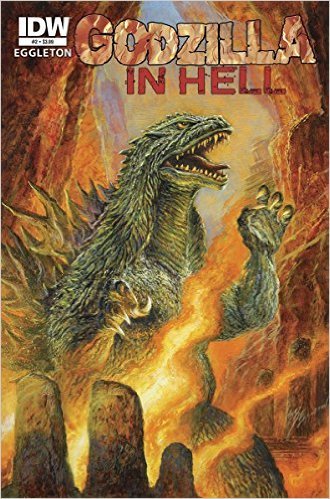
This comic series provides an innovative take on the King of the Monsters as we find our intrepid Gojira making his way through a Dante-inspired underworld wherein he encounters various bizarre landscapes and strange adversarial monstrosities. There is no dialogue, though the imagery suggests what might be passing through Godzilla’s mind on this daunting journey, sinking ever deeper through the haunted circles of Hades.
James Stokoe’s powerful premiere issue begins with a two-page spread done as a triptych of Godzilla’s fall into the abyss. His rendition seems like a nod to the late Millennium series KiryuGoji. Gojira’s first act of defiance is to shatter a towering obelisk built from the words “Abandon all hope ye who enter here.” A collection of buildings resembling a nuclear power plant then draws his attention and a sort of seething Lovecraftian beast lashes out at Godzilla from its resting place in a cooling tower. Swiftly dispatched, a cloud consisting of damned souls furiously batters our hero, only to part and reveal a doppelgänger, bearing wounds. As Godzilla engages his mutilated twin, it morphs hideously, being kin to the alien called “The Thing” which was so well depicted in John Carpenter’s eponymous film. This seems a nod to the American title “Godzilla vs. The Thing” of the 1964 film in which Mothra fought Godzilla. The monstrosity seems to have aspects of Orga and Biollante amongst its biological bag of tricks, and it proves a difficult adversary to defeat before Gojira slips through to a lower level.
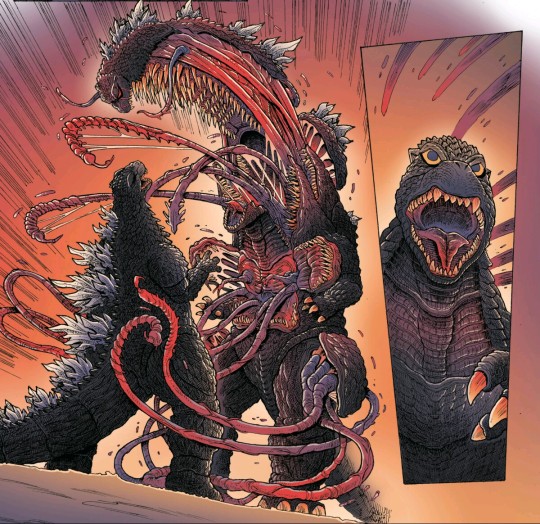
Bob Eggleton’s superlative second issue offers panels painted in a style synthesizing aspects of old masters John Martin, Gustav Doré and J.M.W. Turner. He has conjured our mighty Leviathan in homage to Wakasa’s MireGoji incarnation. Former adversaries from the cinematic canon appear as demon-possessed opponents in successive descending domains. Rodan soars through skies reddened by volcanic eruptions, shot through with bolts of lightening. Anguirus rises to battle amidst damned ships trapped in blue-green glaciers. From a storm-tossed ocean comes Varan, though he is but the prelude to King Ghidorah’s blinding, maelstrom-raising advent.
I’ve long admired Eggleton’s renditions as his masterly brushwork and fine imagination capture the many appearances of Godzilla in iconic imagery, celebrating his elemental power in an almost romantic manner. This issue is a feast, as not only is there a painted cover illustration, but the entire installment consists of gorgeous paintings—possibly a first in daikaiju comics. There are awesome, Hellish vistas and dynamic scenes of combat that could easily be graced by ornate frames and hung in a gallery. From precise details such as Rodan’s silhouette reflected in Godzilla’s eye to the sweeping grandeur of the two-page title spread, you’ll be captivated by the splendid sweeping imagery and pithy, poetic narration.

Godzilla aficionados will find this series an absolute necessity for their collections. With the new Japanese Gojira film in the capable hands of Anno and Higuchi being released next year, as well as the upcoming second installment in Legendary’s series, we who cherish Gojira have much to savor. This comic is a resplendent element in the current Daikaiju renaissance. It shall be fascinating to see where the artists take the indomitable Godzila in the three issues to follow—I’ll certainly be along for the continuing saga!
GODZILLA IN HELL #1 / GODZILLA IN HELL #2
—Magus Peter H. Gilmore
126 notes
·
View notes
Text
How Strange is that Beast called Man?

Last night I watched Aleksei German’s HARD TO BE A GOD, a Russian film reminiscent of Tarkovsky, based on the sci-fi concept of Earth observers embedded on an Earth-like planet in its own middle ages during a time when the populace has decided to massacre anyone with talent, learning, artistic ability or intelligence. It is a truly horrific depiction of man as just another animal, brilliantly shot in black and white. At almost three hours and with a very vague, wandering plot, it is realized in such a way that you feel you are there, witnessing this lasting foulness of a society which is likely close to depicting what it was like in such times in our own past. Memorable, powerful and utterly disgusting, it is thoroughly damning of the worst behavior of our species. This film is mesmerizing and worth your time—it will, I think, linger in your memory as do powerful works of art.
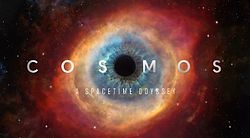
The night before I watched the final four episodes of the 2014 series COSMOS: A SPACETIME ODYSSEY which celebrates invention, intelligence, genius and what could be a more promising future if our species can stop being short-sighted in our lack of concern for the fragility of our planet’s environment. It is a successful revival of Carl Sagan’s original 1980 series meant to excite interest in science and the wonder of understanding the universe in which we live. With the eloquent Neil deGrasse Tyson as host, an astrophysicist who was inspired by Sagan, the episodes feature striking visuals and stirring music by Alan Silvestri. There is plenty of food for thought along the way, though for my taste there is a bit of soft-peddling of the offenses made by theists who strove to stifle science as it came to supplant their limited beliefs. (View Amenábar’s AGORA as a supplement). It is worth your time and can work as a beginning point for learning more about physics, astronomy and the glories of our Universe.
Thus I had a very powerful two nights of antipodal bookending views on the nature of humanity. You also might find both of these experiences to be challenging and enlightening.
—Magus Peter H. Gilmore
46 notes
·
View notes
Photo
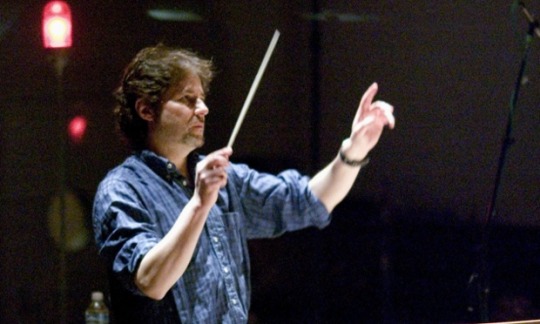
In Memoriam James Horner (1953-2015)
I first encountered composer James Horner’s work when I saw the theatrical release of Corman’s BATTLE BEYOND THE STARS. He impressed me with the skilled symphonic development of his fine thematic material and the savvy references to other composers of film and orchestral music that were woven into his score. I placed him on my radar as being a refreshing new voice in the tradition of Goldsmith, Williams and other masters, so that I could look for his coming scores that I suspected would elevate the films with which they were wed. He did not disappoint.
Horner’s musical vocabulary was derived from the great Western orchestral tradition, from romantic bombast to avant garde soundscapes as well as aspects of folk and popular expression. I could tell that he enjoyed many of the same works as myself since there were direct allusions to Wagner (The Flying Dutchman in the wonderfully propulsive KRULL score), Shostakovich, Prokofiev and others whom I admired. In KRULL and THE WRATH OF KHAN he employed a variant on the grinding climax from the first movement of Britten’s Sinfonia Da Requiem. Clearly this fellow studied and loved the same pieces that I had. I did not see this as a form of theft or repetition, rather it was that Horner used certain musical materials from earlier masters as their emotional meaning was apt for a number of films and would serve the imagery well. And he made them his own.
Horner’s skills in imitating varied musical styles were extraordinary, from the Swing music in COCOON to the impressive blend of dissonance, Mozartian delicacy, and sweepingly transcendant choral passages for BRAINSTORM. His ALIENS score was a fine successor to Goldsmith. With its nod to 2001 through a paraphrase of Khachaturian’s GAYNE—likewise signifying the loneliness of deep space—and the clangor of struck anvils driving forward the desperate efforts of the military, it fully heightened the elements that Cameron had brought to his splendid sequel. For THE NAME OF THE ROSE Horner demonstrated that he could use synthesizers to create evocative sounds suitable for a medieval Sherlock Holmes dealing with the religious suppression of wisdom, joy, and any truth that could threaten tenuous faith.
The heroic sonic tapestry he wove for the second and third STAR TREK films evoked a sense of swashbuckling bravado for Kirk and his crew, offering a potent and iconic set of themes for the courage of the crew of the enterprise, the villainy of Montalban’s Khan, as well as the barbaric aggression of the Klingons, climaxed by the majesty of the result of the detonated Genesis device. He deftly captured stalwart bravery, whether it was successful or not, in scores for GLORY, BRAVEHEART and TROY. Collaborating on Cameron’s TITANIC cemented Horner’s eminence, and won him top awards, and the popularity of the same director’s AVATAR enlivened via Horners exquisitely rendered, complex textures, made certain that his sounds would be known throughout many cultures around the globe.
THE ROCKETEER may be my favorite of all of his scores as it is imbued with an extraordinary sense of nostalgia from the very opening bars that then fulfills all of the various recreated vintage aspects of Johnston’s dazzling film, particularly embodying the exhilarating thrill of solo flight that worked on the same exalted level as had Goldsmith’s brilliant work in THE BLUE MAX. Clearly, flight evoked a very powerful response in Horner, and so while it was a saddening shock to learn that he had died in an accident, it was made less so in that his life was lost while flying solo in a small plane—his final hours spent doing something that clearly meant as much to him as his creative work.
Maestro James Horner has written an extraordinary body of music, well-serving the many and varied films for which it was crafted, but which can also stand on its own for the beauty of its expressive melodies and supporting harmonies, so well orchestrated to create a sound that one could immediately identify with his deeply musical thinking. I am saddened that his life was cut short so that there will not be additional masterworks to expand his oeuvre. I will be enjoying his music as long as I live, my heart soaring with the symphonic glories that will long stand as tribute to his sublime creativity.
Hail James Horner!
—Magus Peter H. Gilmore
40 notes
·
View notes